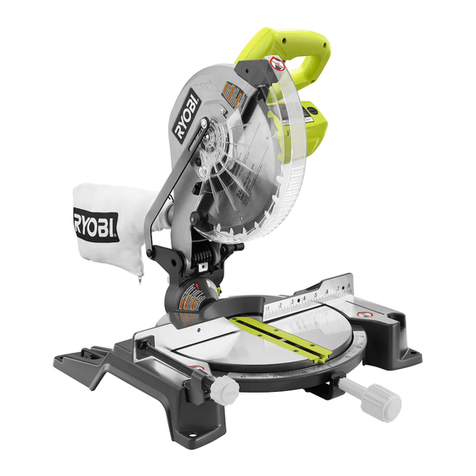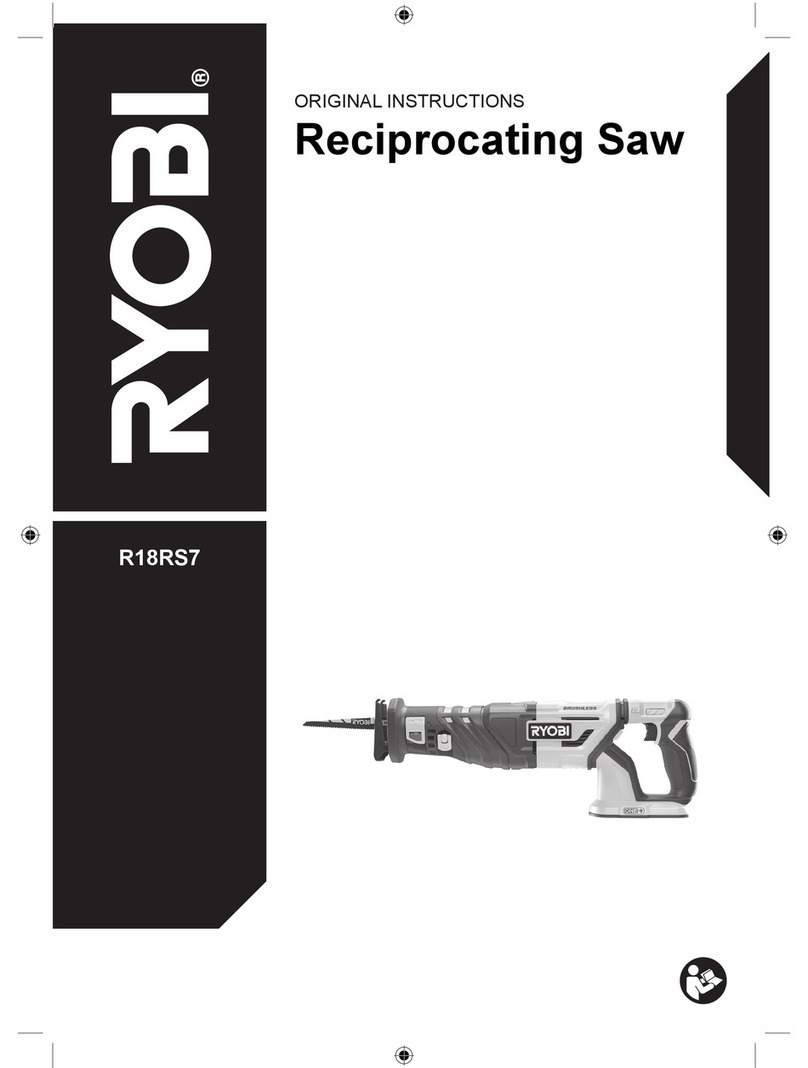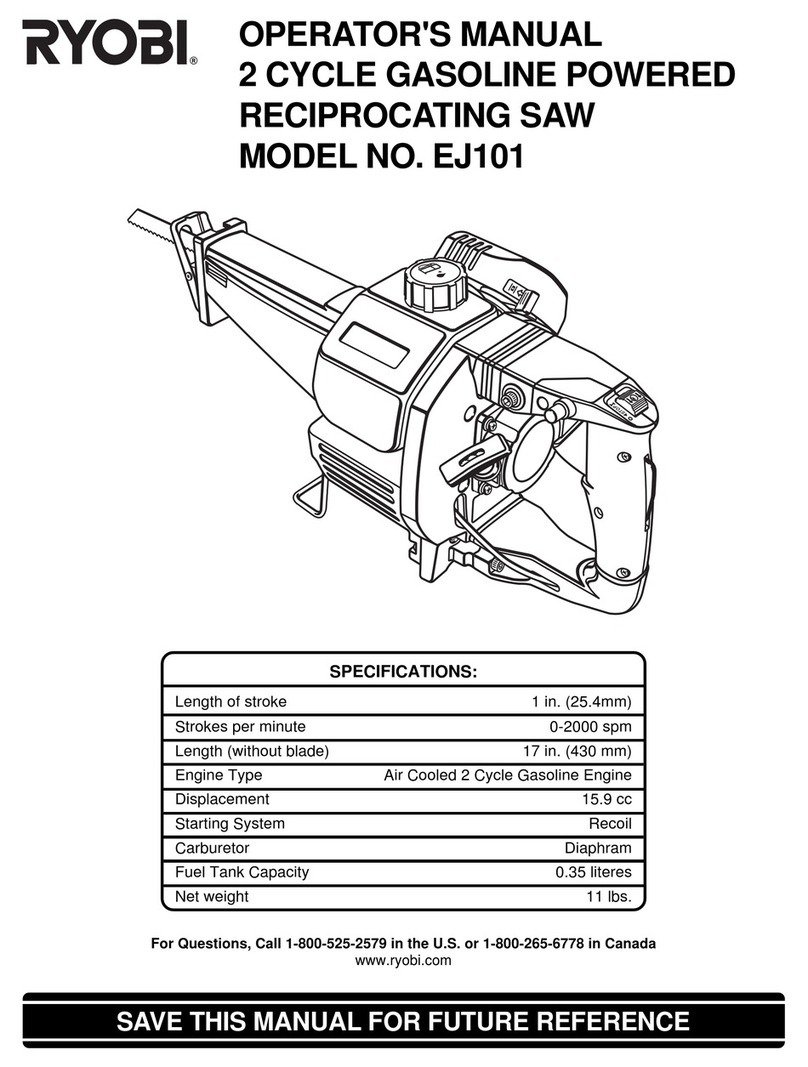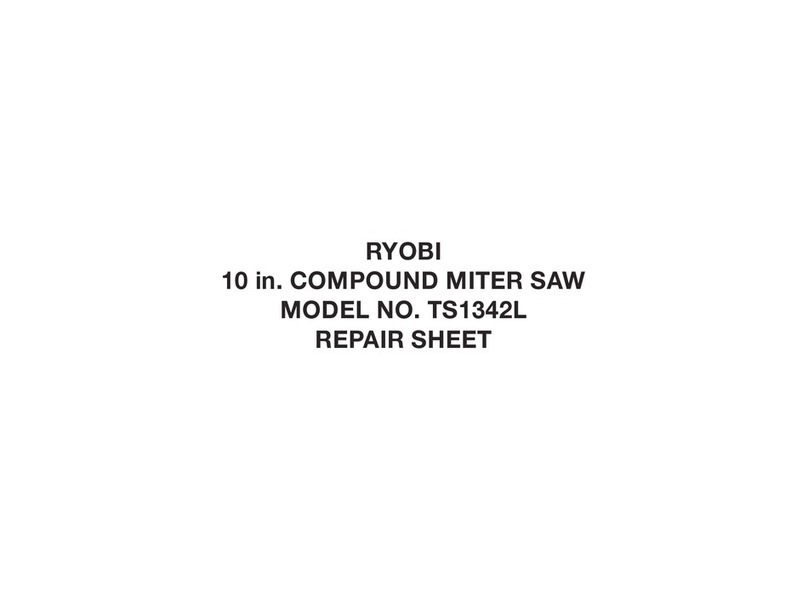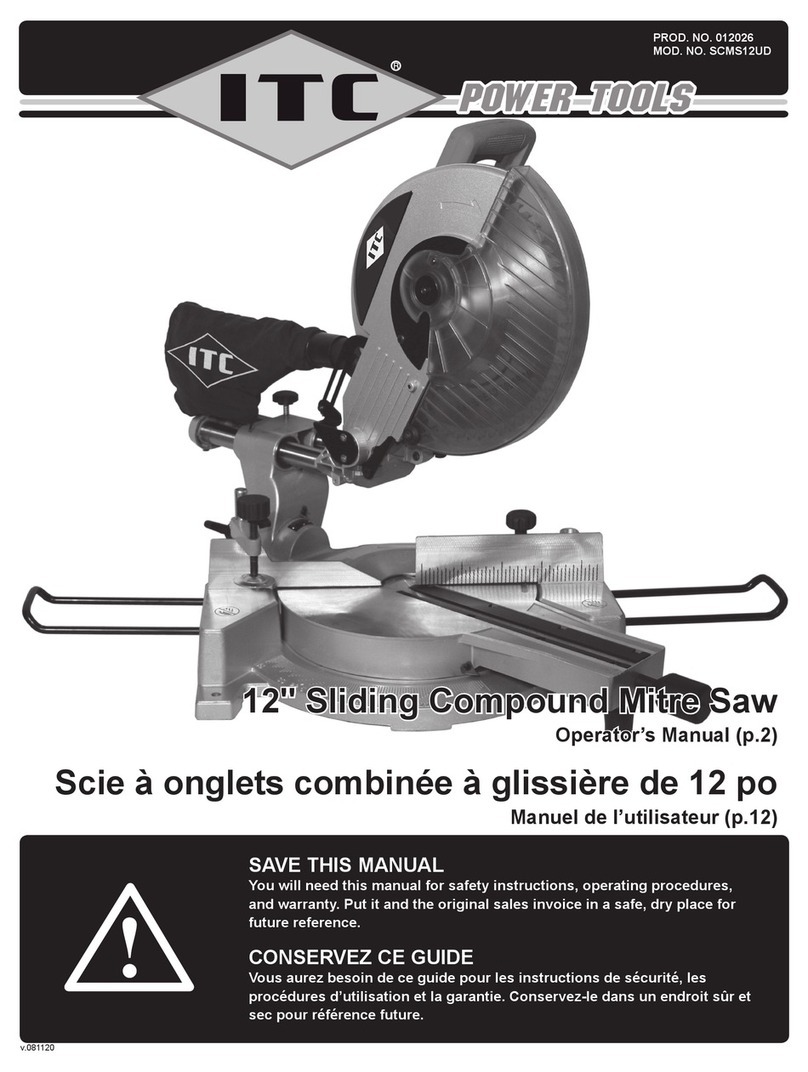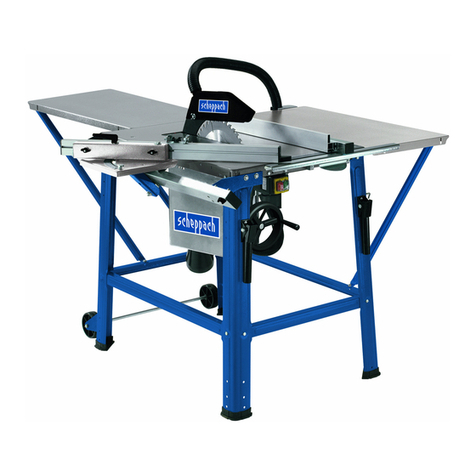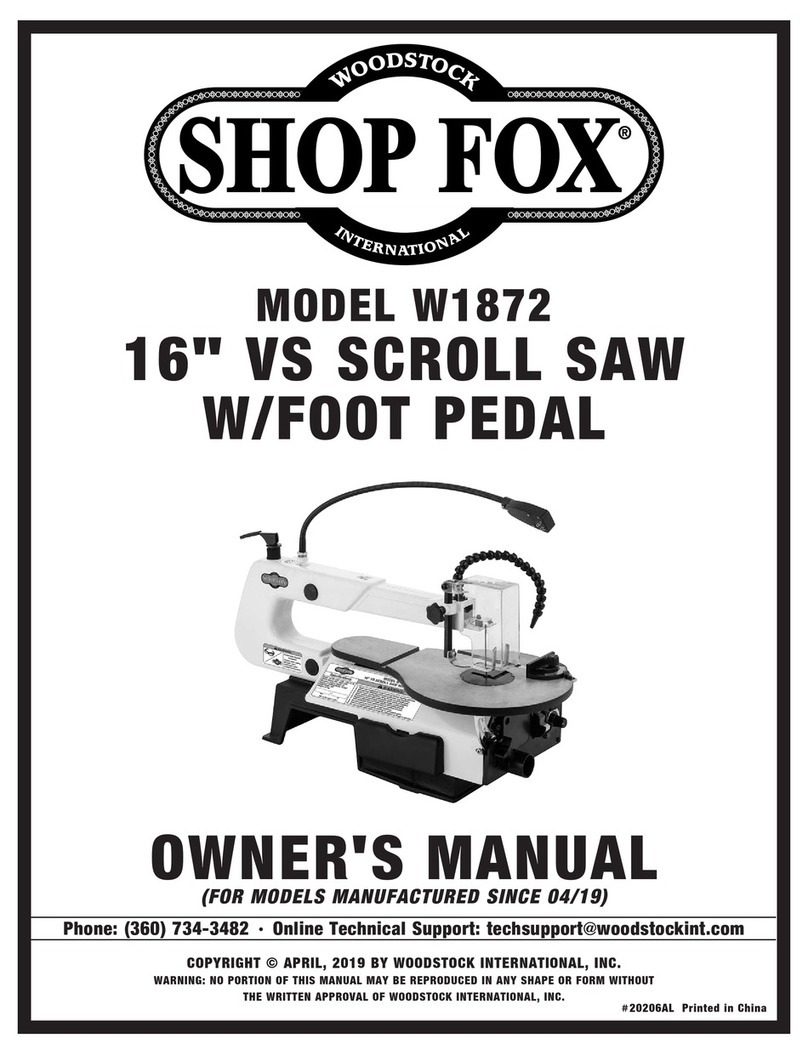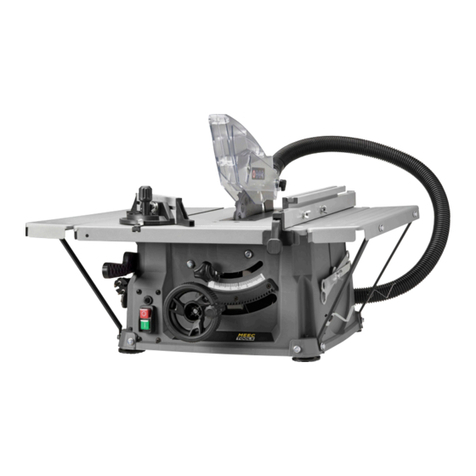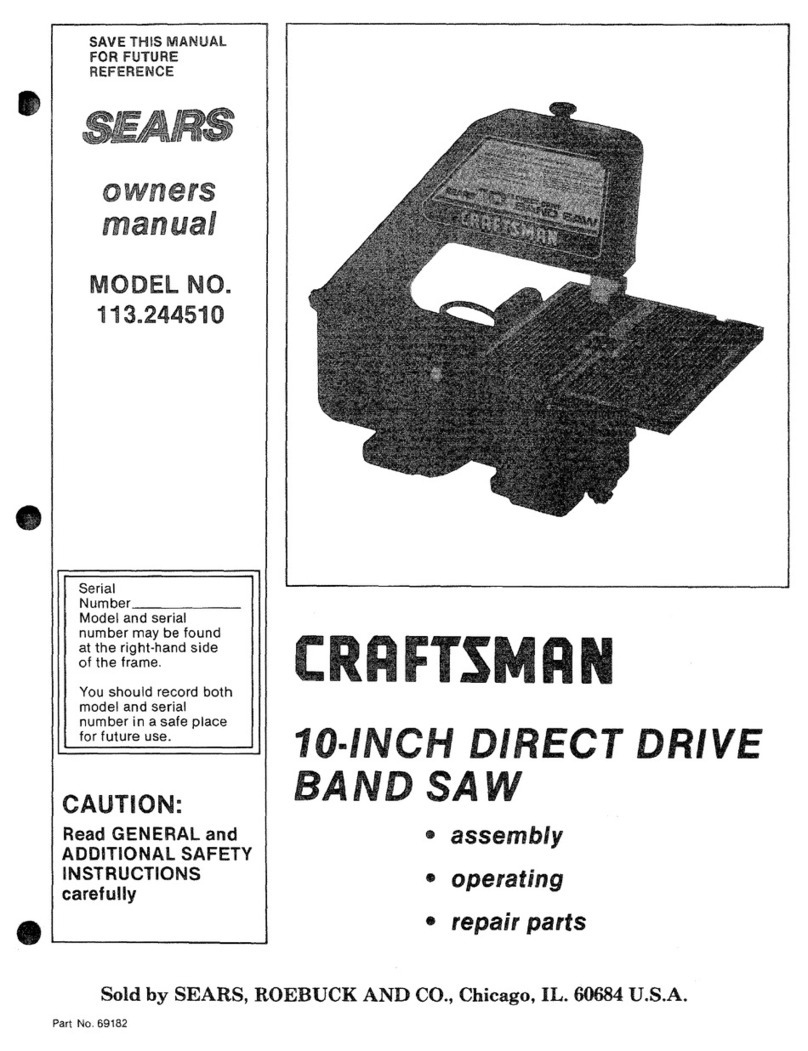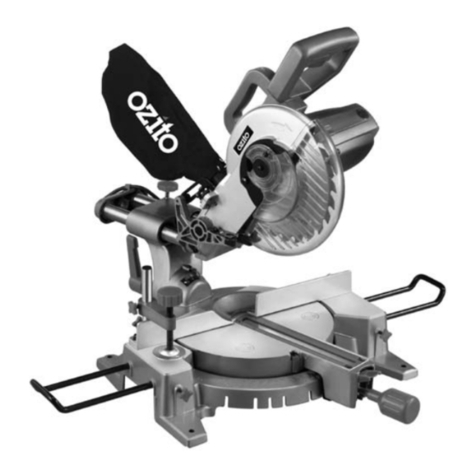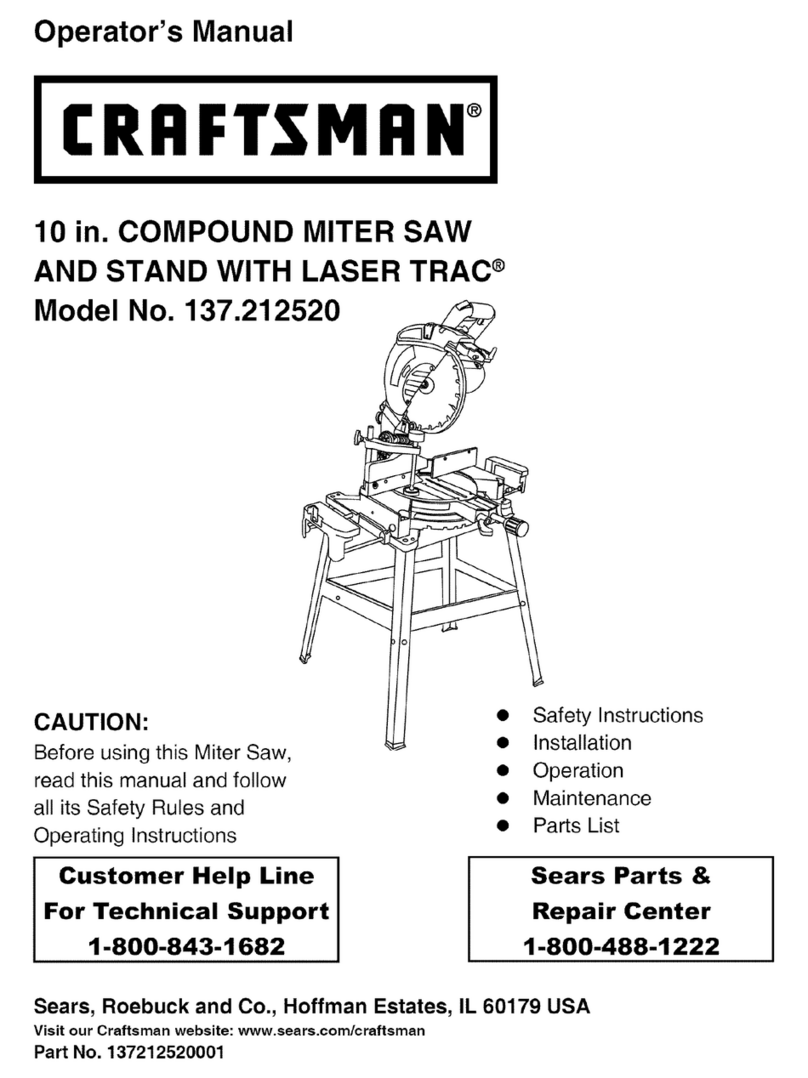Ryobi R18CSP-0 User manual

ORIGINAL INSTRUCTIONS
TRADUCTION DES INSTRUCTIONS ORIGINALES
ÜBERSETZUNG DER ORIGINALANLEITUNG
TRADUCCIÓN DE LAS INSTRUCCIONES ORIGINALES
TRADUZIONE DELLE ISTRUZIONI ORIGINALI
VERTALING VAN DE ORIGINELE INSTRUCTIES
TRADUÇÃO DAS INSTRUÇÕES ORIGINAIS
OVERSÆTTELSE AF DE ORIGINALE INSTRUKTIONER
ÖVERSÄTTNING AV DE URSPRUNGLIGA INSTRUKTIONERNA
ALKUPERÄISTEN OHJEIDEN SUOMENNOS
OVERSETTELSE AV DE ORIGINALE INSTRUKSJONENE
ПЕРЕВОД ОРИГИНАЛЬНЫХ ИНСТРУКЦИЙ
TŁUMACZENIE INSTRUKCJI ORYGINALNEJ
PŘEKLAD ORIGINÁLNÍCH POKYNŮ
AZ EREDETI ÚTMUTATÓ FORDÍTÁSA
TRADUCEREA INSTRUCŢIUNILOR ORIGINALE
TULKOTS NO ORIĢINĀLĀS INSTRUKCIJAS
ORIGINALIŲ INSTRUKCIJŲ VERTIMAS
ORIGINAALJUHENDI TÕLGE
PRIJEVOD ORIGINALNIH UPUTA
PREVOD ORIGINALNIH NAVODIL
PREKLAD ORIGINÁLNYCH POKYNOV
ΜΕΤΆΦΡΑΣΗ ΤΩΝ ΠΡΩΤΌΤΥΠΩΝ ΟΔΗΓΙΏΝ
ORIJ NAL TALIMATLARIN TERCÜMESI
ПЕРЕКЛАД ОРИГІНАЛЬНИХ ІНСТРУКЦІЙ
EN
FR
DE
ES
IT
NL
PT
DA
SV
FI
NO
RU
PL
CS
HU
RO
LV
LT
ET
HR
SL
SK
EL
TR
UK
R18CSP

Important! It is essential that you read the instructions in this manual before assembling, maintaining and
operating the product.
Attention! Il est essentiel que vous lisiez les instructions contenues dans ce manuel avant d’assembler,
d’entretenir et d’utiliser le produit.
Achtung! Es ist wichtig, dass Sie vor Zusammenbau, Wartung und Benutzung des Produktes die Anweisungen
in dieser Anleitung lesen.
¡Atención! Resulta fundamental que lea este manual de instrucciones antes de realizar el montaje, el
mantenimiento y de utilizar este producto
Attenzione! E’ importante leggere le istruzioni contenute nel presente manuale prima di montare il prodotto,
svolgere le operazioni di manutenzione sullo stesso e metterlo in funzione.
Let op! Het is van essentieel belang dat u de instructies in deze gebruiksaanwijzing leest voor u het product
monteert, onderhoudt en gebruikt.
Atenção! É fundamental que leia as instruções deste manual antes da montagem, manutenção e operação
do aparelho.
OBS! Det er vigtigt, at man læser instrukserne i denne brugsanvisning, inden man samler, vedligeholder
og betjener produktet.
Observera! Det är viktigt att du läser instruktionerna i manualen före montering, användning och underhåll av
produkten.
Huomio! On tärkeää, että luet tämän käsikirjan ohjeet ennen tuotteen kokoamista, huoltoa ja käyttöä.
Advarsel! Det er viktig at du leser instruksjonene i denne manualen før sammensetning, vedlikehold og bruk
av produktet
Внимание! Необходимо прочитать инструкции в данном руководстве перед сборкой, обслуживанием и
эксплуатацией этого изделия.
Uwaga! Koniecznie należy przeczytać instrukcje zawarte w tym podręczniku przed montażem, obsługą oraz
konserwacją produktu.
Důležité
upozornění! Neinstalujte, neprovádějte údržbu ani nepoužívejte tento výrobek dříve, než si přečtete pokyny
uvedené v tomto návodu.
Figyelem! Fontos, hogy a termék összeszerelése, karbantartása és használata előtt elolvassa a kézikönyvben
található utasításokat.
Atenţie! Este esențial să citiți instrucțiunile din acest manual înainte de asamblare, efectuarea întreținerii și
operarea produsului.
Uzmanību! Ir svarīgi izlasīt šīs rokasgrāmatas instrukcijas pirms uzstādīšanas, apkopes un preces
darbināšanas.
Dėmesio! Prieš surenkant, prižiūrint ir naudojant gaminį, būtina perskaityti šiame vadove pateiktus nurodymus.
Tähtis! Enne masina kokkupanekut, hooldamist ja kasutama hakkamist tuleb käesolevas juhendis esitatud
juhised kindlasti läbi lugeda.
Upozorenje! Vrlo je važno da ste prije sklapanja, održavanja i rada s ovim proizvodom pročitali upute u ovom
priručniku.
Pomembno! Pomembno je da pred montažo vzdrževanjem in uporabo tega izdelka preberete navodila v tem
priročniku.
Upzornenie! Je dôležité, aby ste si pred montážou, údržbou a obsluhou produktu prečítali pokyny v tomto návode.
Προσοχή! Είναι πολύ σημαντικό να διαβάσετε τις οδηγίες στο παρόν εγχειρίδιο πριν συναρμολογήσετε,
συντηρήσετε ή λειτουργήσετε το προϊόν.
Dikkat! Ürünün montajını, bakımını yapmadan ve ürünü çalıştırmadan önce bu kılavuzda yer alan talimatları
okumanız önemlidir.
Важливо! Дуже важливо, щоб ви прочитали інструкції в цьому керівництві перед складанням,
обслуговуванням та експлуатацією цієї машини.
Subject to technical modication | Sous réserve de modications techniques | Technische Änderungen vorbehalten | Bajo
reserva de modicaciones técnicas | Con riserva di eventuali modiche tecniche | Technische wijzigingen voorbehouden
| Com reserva de modicações técnicas | Med forbehold for tekniske ændringer | Med förbehåll för tekniska ändringar |
Tekniset muutokset varataan | Med forbehold om tekniske endringer | могут быть внесены технические изменения |
Z zastrzeżeniem modykacji technicznych | Změny technických údajů vyhrazeny | A műszaki módosítás jogát fenntartjuk
| Sub rezerva modicaţiilor tehnice | Paturam tiesības mainīt tehniskos raksturlielumus | Pasiliekant teisę daryti techninius
pakeitimus | Tehnilised muudatused võimalikud | Podloæno tehniëkim promjenama | Tehnične spremembe dopuščene |
Právo na technické zmeny je vyhradené | Υπό την επιφύλαξη τεχνικών τροποποιήσεων | Teknik değişiklik hakkı saklıdır |
Є об’єктом для технічних змін

1English |
EN
FR
DE
ES
IT
NL
PT
DA
SV
FI
NO
RU
PL
CS
HU
RO
LV
LT
ET
HR
SL
SK
EL
TR
UK
Safety, performance, and dependability have been given
top priority in the design of your cordless circular saw.
INTENDED USE
The product is intended to be used only by adults who
have read and understood the instructions and warnings
in this manual, and can be considered responsible for their
actions.
The saw is designed for rip- and cross-cutting of wood or
similar materials up to a maximum depth of 45 mm. It can
make straight or bevelled cuts between 0 and 50 degrees.
It is to be used with the base of the tool in contact with
the workpiece. It should only be used in a dry, well lit
and well ventilated area. The circular saw is designed for
handheld use. It is not to be mounted onto a workbench
XQOHVVVSHFL¿FLQVWUXFWLRQVDERXWKRZWRGRWKLVDUHJLYHQ
by the manufacturer of the saw. Do not use for cutting
metal or masonry. Do not use the product in any way other
than those stated for intended use. Use of the product
for operations different from intended could result in a
hazardous situation.
WARNING
Read all safety warnings and all instructions. Failure
to follow the warnings and instructions may result in
HOHFWULFVKRFN¿UHDQGRUVHULRXVLQMXU\
Save all warnings and instructions for future reference.
CIRCULAR SAW SAFETY WARNINGS
CUTTING PROCEDURES
DANGER
Keep hands away from cutting area and the blade.
Keep your second hand on auxiliary handle, or
motor housing. If both hands are holding the saw, they
cannot be cut by the blade.
ŶDo not reach underneath the workpiece. The guard
cannot protect you from the blade below the workpiece.
ŶAdjust the cutting depth to the thickness of the
workpiece. Less than a full tooth of the blade teeth
should be visible below the workpiece.
ŶNever hold piece being cut in your hands or across
your leg. Secure the workpiece to a stable platform.
It is important to support the work properly to minimize
body exposure, blade binding, or loss of control.
ŶHold power tool by insulated gripping surfaces only
when performing an operation where the cutting
tool may contact hidden wiring. Contact with a “live”
wire will also make exposed metal parts of the power
tool “live” and could give the operator an electric shock.
ŶWhen ripping, always use a rip fence or straight
edge guide. This improves the accuracy of cut and
reduces the chance of blade binding.
ŶAlways use blades with correct size and shape
(diamond versus round) of arbour holes. Blades that
do not match the mounting hardware of the saw will run
eccentrically, causing loss of control.
ŶNever use damaged or incorrect blade washers
or bolt. The blade washers and bolt were specially
designed for your saw, for optimum performance and
safety of operation.
KICKBACK CAUSES AND RELATED WARNINGS:
ŶKickback is a sudden reaction to a pinched, bound or
misaligned saw blade, causing an uncontrolled saw to
lift up and out of the workpiece toward the operator.
ŶWhen the blade is pinched or bound tightly by the kerf
closing down, the blade stalls and the motor reaction
drives the unit rapidly back toward the operator.
ŶIf the blade becomes twisted or misaligned in the cut,
the teeth at the back edge of the blade can dig into the
top surface of the wood causing the blade to climb out
RIWKHNHUIDQGMXPSEDFNWRZDUGWKHRSHUDWRU
.LFNEDFN LV WKH UHVXOW RI VDZ PLVXVH DQGRU LQFRUUHFW
operating procedures or conditions and can be avoided by
taking proper precautions as given below.
ŶMaintain a firm grip with both hands on the saw
and position your arms to resist kickback forces.
Position your body to either side of the blade, but
not in line with the blade. Kickback could cause the
VDZ WR MXPS EDFNZDUGV EXW NLFNEDFN IRUFHV FDQ EH
controlled by the operator, if proper precautions are
taken.
ŶWhen blade is binding, or when interrupting a cut
for any reason, release the trigger and hold the saw
motionless in the material until the blade comes
to a complete stop. Never attempt to remove the
saw from the work or pull the saw backward while
the blade is in motion or kickback may occur.
Investigate and take corrective actions to eliminate the
cause of blade binding.
ŶWhen restarting a saw in the workpiece, centre the
saw blade in the kerf and check that saw teeth are
not engaged into the material. If saw blade is binding,
it may walk up or kickback from the workpiece as the
saw is restarted.
ŶSupport large panels to minimise the risk of blade
pinching and kickback. Large panels tend to sag
under their own weight. Supports must be placed under
the panel on both sides, near the line of cut and near
the edge of the panel.
ŶDo not use dull or damaged blades. Unsharpened
or improperly set blades produce narrow kerf causing
excessive friction, blade binding and kickback.
ŶBlade depth and bevel adjusting locking levers
must be tight and secure before making cut. If blade
DGMXVWPHQW VKLIWV ZKLOH FXWWLQJ LW PD\ FDXVH ELQGLQJ
and kickback.
ŶUse extra caution when sawing into existing walls
or other blind areas. The protruding blade may cut
REMHFWVWKDWFDQFDXVHNLFNEDFN
LOWER GUARD FUNCTION
ŶCheck lower guard for proper closing before each
use. Do not operate the saw if lower guard does not

2| English
move freely and close instantly. Never clamp or
tie the lower guard into the open position. If saw is
accidentally dropped, lower guard may be bent. Raise
the lower guard with the retracting handle and make
sure it moves freely and does not touch the blade or any
other part, in all angles and depths of cut.
ŶCheck the operation of the lower guard spring. If
the guard and the spring are not operating properly,
they must be serviced before use. Lower guard may
operate sluggishly due to damaged parts, gummy
deposits, or a build-up of debris.
ŶLower guard may be retracted manually only for
special cuts such as “plunge cuts” and “compound
cuts”. Raise lower guard by retracting handle and as
soon as blade enters the material, the lower guard
must be released. For all other sawing, the lower guard
should operate automatically.
ŶAlways observe that the lower guard is covering the
blade before placing saw down on bench or floor.
An unprotected, coasting blade will cause the saw to
walk backwards, cutting whatever is in its path. Be
aware of the time it takes for the blade to stop after
switch is released.
ADDITIONAL SAFETY WARNINGS
ŶThe dust produced when using the product may be
harmful to your health, inflammable, or explosive.
Do not inhale the dust. Use a dust extraction system,
and wear a suitable dust protection mask. Remove
deposited dust thoroughly, e.g., with a brush and
vacuum cleaner.
ŶDo not use any abrasive wheels.
ŶUse only blades specified in this manual, complying
with EN 847-1.
ŶAvoid overheating the blade tips. Do not use dull or
damaged blades. Do not force the tool.
ŶDo not use blades of larger or smaller diameter than
recommended.
ŶWear ear protection.
ŶClamp workpiece with a clamping device.
8QFODPSHG ZRUNSLHFHV FDQ FDXVH VHYHUH LQMXU\ DQG
damage.
ŶThoroughly check the material to be cut, particularly
when using recycled wood, for foreign objects such
as nails, screws, and staples. If nails, screws, staples
or similar items contact the blade whilst cutting, the saw
ZLOOEHGDPDJHG DQG VHYHUH LQMXU\ WR WKH RSHUDWRURU
others may occur.
ŶDo not touch the saw blade immediately after
sawing. The saw blade gets hot during sawing.
TRANSPORTING LITHIUM BATTERIES
Transport the battery in accordance with local and national
provisions and regulations.
Follow all special requirements on packaging and labelling
when transporting batteries by a third party. Ensure that
no batteries can come in contact with other batteries
or conductive materials while in transport by protecting
exposed connectors with insulating, non-conductive caps
or tape. Do not transport batteries that are cracked or
leaking. Check with the forwarding company for further
advice.
RESIDUAL RISKS
Even when the product is used as prescribed, it is still
impossible to completely eliminate certain residual risk
factors. The following hazards may arise and the operator
should pay special attention to avoid the following:
Ŷ,QMXU\FDXVHGE\NLFNEDFN
–Read and understand the information in this manual.
Ŷ,QMXU\FDXVHGE\YLEUDWLRQ
–Limit exposure. See Risk Reduction.
Ŷ,QMXU\FDXVHGE\GXVW
–Wear eye protection at all times. Wear appropriate
dust mask with suitable filters that can protect
against particles from the material being worked on.
Do not eat, drink, or smoke in the work area. Ensure
adequate ventilation.
ŶElectric shock
–The blade may contact hidden wiring causing
parts of the product to become live. Always hold
the product by the designated handles and take
care when blind-cutting into walls and floors where
cables may be hidden.
NOTE: When working on walls, ceilings, or floors, take
care to avoid electric cables and gas or water pipes.
Ŷ,QMXU\IURPFRQWDFWZLWKWKHFXWWLQJEODGH
–The blades are sharp and will become hot during
use. Wear gloves when changing blades. Keep
hands away from the cutting area at all times. Never
hold workpiece being cut in your hands or across
your leg. Clamp the work piece whenever possible.
RISK REDUCTION
It has been reported that vibrations from handheld tools
may contribute to a condition called Raynaud’s Syndrome
in certain individuals. Symptoms may include tingling,
QXPEQHVVDQGEODQFKLQJRIWKH¿QJHUVXVXDOO\DSSDUHQW
upon exposure to cold. Hereditary factors, exposure to
cold and dampness, diet, smoking, and work practices
are all thought to contribute to the development of these
symptoms. There are measures that can be taken by the
operator to possibly reduce the effects of vibration:
ŶKeep your body warm in cold weather. When operating
the unit, wear gloves to keep the hands and wrists
ZDUP,WLVUHSRUWHGWKDWFROGZHDWKHULVDPDMRUIDFWRU
contributing to Raynaud’s Syndrome.
ŶAfter each period of operation, exercise to increase
blood circulation.
ŶTake frequent work breaks. Limit the amount of
exposure per day.
If you experience any of the symptoms of this condition,
immediately discontinue use and see your doctor about
these symptoms.

3English |
EN
FR
DE
ES
IT
NL
PT
DA
SV
FI
NO
RU
PL
CS
HU
RO
LV
LT
ET
HR
SL
SK
EL
TR
UK
WARNING
,QMXULHV PD\ EH FDXVHG RU DJJUDYDWHG E\ SURORQJHG
use of a tool. When using any tool for prolonged periods,
ensure you take regular breaks.
KNOW YOUR PRODUCT
See page 102.
1. Edge guide knob
2. %HYHODGMXVWPHQWNQRE
3. Spindle lock button
4. Front handle
5. Lock-off button
6. Switch trigger
7. Battery port
8. 'XVW3LSHMRLQW
9. Inner flange
10. Outer flange
11. Blade Screw
12. Hex key
13. 'HSWKDGMXVWPHQWORFNOHYHU
14. Edge guide fence
15. Blade
MAINTENANCE
WARNING
The product should never be connected to a power
VXSSO\ ZKHQ DVVHPEOLQJ SDUWV PDNLQJ DGMXVWPHQWV
cleaning, performing maintenance, or when the product
is not in use. Disconnecting the product will prevent
DFFLGHQWDOVWDUWLQJWKDWFRXOGFDXVHVHULRXVLQMXU\
ŶWhen servicing, use only identical replacement parts.
Use of any other parts may create a hazard or cause
product damage.
ŶAvoid using solvents when cleaning plastic parts. Most
plastics are susceptible to various types of commercial
solvents and may be damaged by their use. Use clean
cloths to remove dirt and carbon dust.
ŶDo not, at any time, let brake fluids, gasoline, petroleum-
based products, penetrating oils, etc., come in contact
with plastic parts. They contain chemicals that can
damage, weaken, or destroy plastic.
ŶAlways wear safety goggles or safety glasses with side
shields during power tool operation or when blowing
dust. If operation is dusty, also wear a dust mask.
ŶFor greater safety and reliability, all repairs should be
performed by an authorised service centre.
LUBRICATION
All of the bearings in the product are lubricated with a
VXI¿FLHQWDPRXQWRIKLJKJUDGHOXEULFDQWIRUWKHOLIHVSDQRI
the product under normal operating conditions. Therefore,
no further lubrication is required.
ENVIRONMENTAL PROTECTION
Recycle raw materials instead of disposing
of as waste. The machine, accessories, and
packaging should be sorted for environment-
friendly recycling.
SYMBOLS ON THE PRODUCT
Safety alert
No-load speed
V Volts
Direct current
min-1 Revolutions or reciprocations per minute
Wood
Do not cut metals
Wear eye protection
Danger! Sharp blade
Do not expose to rain
Width of cut
Blade teeth
CE conformity
EurAsian Conformity Mark
Ukrainian mark of conformity
Please read the instructions carefully
before starting the machine.

4| English
Waste electrical products should not
be disposed of with household waste.
Please recycle where facilities exist.
Check with your local authority or
retailer for recycling advice.
SYMBOLS IN THIS MANUAL
Note
Waiting time
The following signal words and meanings are intended to
explain the levels of risk associated with this product:
DANGER
Indicates an imminently hazardous situation, which, if not
DYRLGHGZLOOUHVXOWLQGHDWKRUVHULRXVLQMXU\
WARNING
Indicates a potentially hazardous situation, which, if not
DYRLGHGFRXOGUHVXOWLQGHDWKRUVHULRXVLQMXU\
CAUTION
Indicates a potentially hazardous situation, which, if not
DYRLGHGPD\UHVXOWLQPLQRURUPRGHUDWHLQMXU\
CAUTION
(Without Safety Alert Symbol) Indicates a situation that
may result in property damage.

5Français |
EN
FR
DE
ES
IT
NL
PT
DA
SV
FI
NO
RU
PL
CS
HU
RO
LV
LT
ET
HR
SL
SK
EL
TR
UK
9RWUH VFLH FLUFXODLUH VDQV ¿O D pWp FRQoXH HQ GRQQDQW
SULRULWpjODVpFXULWpjODSHUIRUPDQFHHWjOD¿DELOLWp
UTILISATION PRÉVUE
/DVFLHFLUFXODLUHGRLWrWUHXWLOLVpHVHXOHPHQWSDUGHVDGXOWHV
ayant lu et compris les instructions et les avertissements
LQFOXVGDQVOHSUpVHQWPDQXHOHWSRXYDQWrWUHFRQVLGpUpV
comme responsables de leurs actes.
/D VFLH HVW FRQoXH SRXU GHV FRXSHV WUDQVYHUVDOHV HW
ORQJLWXGLQDOHV GDQV OH ERLV RX GHV PDWpULDX[ VLPLODLUHV
MXVTX¶j XQH SURIRQGHXU PD[LPDOH GH PLOOLPqWUHV /HV
FRXSHV SHXYHQW rWUH GURLWHV RX HQ ELVHDX j XQ DQJOH
compris entre 0 et 50°. La base de l’appareil doit rester
HQ FRQWDFW DYHF OD SLqFH j WUDYDLOOHU /D VFLH GRLW rWUH
XWLOLVpHSDUFRQGLWLRQVVqFKHVVRXVXQH[FHOOHQWpFODLUDJH
DPELDQW HW DYHF XQH YHQWLODWLRQ DGpTXDWH /D VFLH HVW
FRQoXH SRXU rWUH WHQXH j OD PDLQ /D VFLH QH GRLW SDV
rWUH¿[pHj XQ pWDEOL VDXI VL GHV LQVWUXFWLRQVVSpFL¿TXHV
IRXUQLHVSDUOHIDEULFDQWGXSURGXLWRQWpWpGRQQpHVVXUOD
IDoRQGHSURFpGHU1HO¶XWLOLVH]SDVSRXUFRXSHUGXPpWDO
RXGHVPDWpULDX[GHPDoRQQHULH1HYRXVVHUYH]SDVGH
FHSURGXLWSRXUG¶DXWUHVXWLOLVDWLRQVTXHFHOOHVGpFULWHVDX
FKDSLWUH GHV XWLOLVDWLRQV SUpYXHV /¶XWLOLVDWLRQ GpWRXUQpH
G¶XQRXWLOpOHFWULTXHHQWUDvQHGHVVLWXDWLRQVGDQJHUHXVHV
AVERTISSEMENT
Lisez attentivement tous les avertissements et
toutes les instructions. Le non-respect des instructions
SUpVHQWpHV FLDSUqV SHXW HQWUDvQHU GHV DFFLGHQWV WHOV
TXHGHVLQFHQGLHVGHVGpFKDUJHVpOHFWULTXHVHWRXGHV
blessures corporelles graves.
Conservez ces avertissements et instructions pour
pouvoir vous y reporter ultérieurement.
AVERTISSEMENTS DE SECURITE CONCERNANT
LA SCIE CIRCULAIRE
PROCÉDURES DE COUPE
DANGER
Éloignez vos mains de la lame et de la zone de
coupe. La main qui ne tient pas la poignée principale
de l'outil doit tenir la poignée auxiliaire ou bien
être posée sur le carter moteur. Ainsi, vos mains ne
risqueront pas de se trouver dans la zone de coupe, sur
ODWUDMHFWRLUHGHODODPH
ŶNe tentez pas d’atteindre le dessous de l’élément à
couper./HSURWqJHODPHQHSHXWSDVYRXVSURWpJHUGH
ODODPHVRXVODSLqFHjFRXSHU
ŶRéglez la profondeur de coupe en fonction de
l’épaisseur de la pièce à usiner. Les dents de la lame
QHGRLYHQWSDVGpSDVVHUHQWLqUHPHQWVRXVODSLqFHj
usiner lors de la coupe.
ŶNe tenez JAMAIS la pièce à usiner avec votre main
ou entre vos jambes. Fixez-la sur un support stable.
,OHVWSULPRUGLDOGHIL[HUFRUUHFWHPHQWODSLqFHjXVLQHU
SRXUpYLWHUWRXWULVTXHGHEOHVVXUHVHWGHQHSDVSOLHUOD
lame afin de ne pas perdre le contrôle de l’outil.
ŶLorsque vous effectuez une opération où
l’accessoire de coupe risque d’entrer en contact
avec un câble électrique caché, maintenez l’outil
par ses surfaces isolées. /¶HQWUpHHQFRQWDFWDYHFXQ
ILOpOHFWULTXH © VRXVWHQVLRQªSRXUUDLWYpKLFXOHU FHWWH
WHQVLRQpOHFWULTXHYHUVOHVSDUWLHVPpWDOOLTXHVGHO¶RXWLO
HWH[SRVHUO¶RSpUDWHXUjXQHGpFKDUJHpOHFWULTXH
ŶUtilisez toujours un guide de coupe parallèle ou
un tasseau droit lorsque vous effectuez une coupe
parallèle. /D SUpFLVLRQ GH FRXSH VHUD DPpOLRUpH HW
YRXVpYLWHUH]OHVULVTXHVGHSOLHUODODPH
ŶUtilisez toujours des lames dont la taille et la forme
sont adaptées à l’alésage de l’arbre. Des lames non
DGDSWpHVjO¶DUEUHVXUOHTXHOHOOHVGRLYHQWrWUHPRQWpHV
ne tourneront pas correctement et peuvent vous faire
perdre de contrôle de l’outil.
ŶN’utilisez jamais de vis ni de flasques de lame
défectueux ou inadaptés. Les flasques et vis de lame
RQWpWpFRQoXVVSpFLDOHPHQWSRXUYRWUHPRGqOHGHVFLH
SRXUXQHVpFXULWpHWXQHSHUIRUPDQFHRSWLPDOHV
AVERTISSEMENTS RELATIFS AU REBOND ET
AUTRES RISQUES ASSOCIÉS :
Ŷ/HUHERQGHVWXQHUpDFWLRQVRXGDLQHTXLDOLHXORUVTXH
ODODPHVHSLQFHVHWRUGRXVLHOOHHVWPDODOLJQpHOD
VFLHVHGpVHQJDJHVRXGDLQHPHQWGHODSLqFHjXVLQHU
et recule violemment en direction de l’utilisateur.
ŶLorsque la lame se pince dans le bois, la lame cale et
OHPRWHXUTXLFRQWLQXHjWRXUQHUSURMHWWHODVFLHGDQV
OHVHQVRSSRVpDXVHQVGHURWDWLRQGHODODPHF¶HVWj
dire vers l’utilisateur.
Ŷ6LODODPHVHWRUGRXHVWPDODOLJQpHOHVGHQWVVLWXpHV
j O¶DUULqUH GH OD ODPH ULVTXHQW GH V¶HQIRQFHU GDQV OD
surface du bois, ce qui fera sortir brusquement la lame
GHODSLqFHjXVLQHUHQGLUHFWLRQGHO¶XWLOLVDWHXU
/HUHERQG HVW GRQF OHUpVXOWDWG¶XQHPDXYDLVHXWLOLVDWLRQ
GHO¶RXWLO HWRX GHSURFpGXUHVRXGH FRQGLWLRQV GHFRXSH
LQFRUUHFWHV ,O SHXW rWUH pYLWp HQ YHLOODQW j UHVSHFWHU
TXHOTXHVSUpFDXWLRQV
ŶMaintenez fermement la scie avec vos deux mains
et positionnez vos bras de façon à ce qu'ils puissent
contrôler un éventuel rebond. Positionnez-vous
d'un côté de la scie lorsque vous travaillez mais ne
vous placez jamais dans l'alignement de la lame.
/HUHERQGSURMHWWHVRXGDLQHPHQWODVFLHYHUVODUULqUH
PDLVFHPRXYHPHQWSHXWrWUHFRQWU{OpVLOXWLOLVDWHXUV\
DWWHQGHWV\SUpSDUH
ŶSi la lame se coince, ou si vous devez interrompre
la coupe pour une raison quelconque, relâchez la
gâchette et maintenez la scie dans la pièce à usiner
jusqu’à ce que la lame s’arrête complètement
de tourner. Ne tentez jamais d’enlever la lame de
l’élément à couper ou de la faire reculer tant que
le disque continue de tourner, sous peine de
provoquer un rebond. Si la lame se coince, cherchez-
HQ OD FDXVH HW SUHQH] OHV PHVXUHV QpFHVVDLUHV SRXU
que cela ne se reproduise plus.
ŶAvant de faire redémarrer la scie pour reprendre
une coupe, alignez correctement la lame avec le

6| Français
trait de scie et vérifiez que les dents ne touchent
pas la pièce à usiner.6LODODPHHVWFRLQFpHGDQVOD
SLqFHjXVLQHUXQUHERQGULVTXHGHVHSURGXLUHORUVGH
la mise en marche de la scie.
ŶVeillez à soutenir les longues pièces à usiner afin
d’éviter que la lame se coince et limiter ainsi les
risques de rebonds. /HV ORQJXHV SLqFHV j XVLQHU
RQW WHQGDQFH j SOR\HU VRXV OHXU SURSUH SRLGV 9RXV
SRXYH]SODFHUGHVVXSSRUWVGHVGHX[F{WpVGHODSLqFH
j XVLQHU SUqV GH OD OLJQH GH FRXSH HW DX QLYHDX GH
OH[WUpPLWpGHODSLqFH
ŶN'utilisez pas de lames émoussées ou
endommagées.'HV ODPHV QRQ DLJXLVpHV RX PDO
PRQWpHVSURGXLURQWXQWUDLWGHVFLHILQHQWUDvQDQWXQH
friction excessive de la lame et donc de plus grands
risques de torsion et de rebond.
ŶAvant de commencer une coupe, vérifiez que
les boutons de réglage de la profondeur et de
l'inclinaison sont correctement bloqués. Si les
UpJODJHVGHODSRVLWLRQGHODODPHVHPRGLILHQWHQFRXUV
de coupe, la lame risque de se coincer et un rebond
peut se produire.
ŶSoyez particulièrement attentif lorsque vous
effectuez une coupe dans un mur existant ou
d’autres zones aveugles. La lame pourrait heurter des
pOpPHQWVFDFKpVFHTXLHQWUDvQHUDLWXQUHERQG
FONCTIONNEMENT DE LA PROTECTION INFÉRIEURE
ŶAvant chaque utilisation, vérifiez que le protège-
lame inférieur recouvre correctement la lame.
N'utilisez pas votre scie si le protège-lame inférieur
ne peut pas être actionné librement et s'il ne se
rabat pas instantanément sur la lame. Ne fixez
ou n'attachez jamais le protège-lame inférieur
en position ouverte. 6L OD VFLH WRPEDLW GH IDoRQ
DFFLGHQWHOOHOHSURWqJHODPHLQIpULHXUSRXUUDLWVHSOLHU
5HOHYH]OHSURWqJHODPHLQIpULHXUjODLGHGHODPDQHWWH
HWDVVXUH]YRXVTXLOSHXWrWUHPDQLSXOpVDQVGLIILFXOWp
HWTXLOQHWRXFKHQLODODPHQLDXFXQHDXWUHSLqFHTXHOV
TXHVRLHQWODQJOHHWODSURIRQGHXUGHFRXSHFKRLVLV
ŶAssurez-vous que le ressort du protège-lame
inférieur est en bon état et fonctionne correctement.
Si le protège-lame ou le ressort ne fonctionnent
pas correctement, faites-les réparer ou remplacer
avant d'utiliser votre scie. /D SURWHFWLRQ LQIpULHXUH
SHXW IRQFWLRQQHU GH IDoRQ OHQWH VL GHV pOpPHQWV VRQW
HQGRPPDJpVHQFDVGHGpS{WVJRPPHX[RXHQFDV
GDFFXPXODWLRQGHGpEULV
ŶLe protège-lame inférieur ne doit être rétracté à la
main que pour des coupes spéciales telles que les «
coupes plongeantes » et les « coupes combinées ».
/HYH]OHSURWqJHODPHLQIpULHXUjODLGHGHODPDQHWWH
3XLVGqVTXHODODPHSpQqWUHGDQVODSLqFHjXVLQHU
UHOkFKH]OHSURWqJHODPHLQIpULHXU Pour tous les autres
W\SHV GH FRXSH OH SURWqJHODPH LQIpULHXU VH PHW HQ
place automatiquement.
ŶVérifiez toujours que le protège-lame inférieur
recouvre bien la lame avant de poser votre scie
sur un établi ou sur le sol. Si la lame n’est pas
correctement recouverte, elle peut tourner par inertie
HW FRXSHU FH TXL VH WURXYH VXU VD WUDMHFWRLUH 6R\H]
conscient du fait que la lame continue de tourner
SHQGDQWXQFHUWDLQWHPSVDSUqVO¶DUUrWGXPRWHXU
INSTRUCTIONS DE SÉCURITÉ ADDITIONNELLES
ŶLa poussière/sciure générée lors de l’utilisation
du produit peut être préjudiciable à votre santé,
inflammable ou explosive. N’inhalez pas la sciure.
8WLOLVH] XQ GLVSRVLWLI G¶DVSLUDWLRQ GH OD SRXVVLqUH
HW SRUWH] XQ PDVTXH GH SURWHFWLRQ DGDSWp 5HWLUH]
VRLJQHXVHPHQWODVFLXUHSDUH[jO¶DLGHG¶XQDVSLUDWHXU
ŶN’utilisez jamais de disque abrasif.
ŶN’utilisez que les lames spécifiées dans ce manuel,
répondant à la norme EN 847-1.
ŶÉvitez de faire surchauffer les dents de la
lame. N’utilisez pas de lames émoussées ou
endommagées. Ne faites pas forcer l’outil.
ŶN’utilisez pas de lames d’un diamètre supérieur ou
inférieur à celui recommandé.
ŶPortez une protection auditive.
ŶSécurisez la pièce à usiner à l’aide d’un dispositif
de serrage. 8QHSLqFHjXVLQHUQRQIL[pHSHXWrWUHOD
cause de blessures graves et de dommages.
ŶVérifier soigneusement le matériau à couper, en
particulier s’il s’agit de bois de récupération, à la
recherche d’objets étrangers tels que clous, vis, et
agrafes. Si des clous, des vis, des agrafes ou autres
REMHWV VLPLODLUHV HQWUHQW HQ FRQWDFW DYHF OD ODPH HQ
FRXUV GH FRXSH FHOOHFL V¶HQ WURXYHUD HQGRPPDJpH
HWGHJUDYHVEOHVVXUHVSRXUUDLHQWrWUHRFFDVLRQQpHVj
O¶RSpUDWHXURXDXWUHVSHUVRQQHV
ŶNe touchez pas la lame de scie immédiatement
après une coupe. La lame de scie devient chaude au
cours de la coupe.
TRANSPORT DES BATTERIES AU LITHIUM
7UDQVSRUWH] OHV EDWWHULHV HQ FRQIRUPLWp DYHF OHV
GLVSRVLWLRQVHWUqJOHPHQWVORFDX[HWQDWLRQDX[
5HVSHFWH] WRXWHV OHV H[LJHQFHV OpJDOHV SDUWLFXOLqUHV
FRQFHUQDQW O¶HPEDOODJH HW O¶pWLTXHWDJH GHV EDWWHULHV
ORUVTXH YRXV FRQ¿H] OHXU WUDQVSRUW j XQ WLHUV $VVXUH]
vous qu’aucune batterie ne puisse entrer en contact avec
XQHDXWUHEDWWHULHRXDYHFGHVPDWpULDX[FRQGXFWHXUVORUV
GHVRQWUDQVSRUWHQLVRODQWOHVERUQHVpOHFWULTXHVDYHFGX
UXEDQDGKpVLIRXGHVFDSXFKRQVLVRODQWV1HWUDQVSRUWH]
pas une batterie qui serait fendue ou qui fuirait. Demandez
conseil au transporteur pour de plus amples informations.
RISQUES RÉSIDUELS
0rPH ORUVTXH OH SURGXLW HVW XWLOLVp VHORQ OHV SUHVFULSWLRQV LO
UHVWHLPSRVVLEOHGpOLPLQHUWRWDOHPHQWFHUWDLQVIDFWHXUVGHULVTXH
UpVLGXHOV /HV GDQJHUV VXLYDQWV ULVTXHQW GH VH SUpVHQWHU HQ
FRXUVGXWLOLVDWLRQHWOXWLOLVDWHXUGRLWSUrWHUSDUWLFXOLqUHPHQWJDUGH
aux points suivants :
ŶBlessures dues au rebond
–/LVH]OHV LQIRUPDWLRQV GH FHPDQXHOGHPDQLqUHj OHV
comprendre.
ŶBlessures dues aux vibrations
–/LPLWH]O¶H[SRVLWLRQ9RLU©5pGXFWLRQGHVULVTXHVª

7Français |
EN
FR
DE
ES
IT
NL
PT
DA
SV
FI
NO
RU
PL
CS
HU
RO
LV
LT
ET
HR
SL
SK
EL
TR
UK
Ŷ%OHVVXUHVGXHVjODSRXVVLqUH
–7RXMRXUV SRUWHU XQH SURWHFWLRQ SRXU OHV \HX[ 3RUWH]
XQ PDVTXH DQWLSRXVVLqUH DSSURSULp pTXLSp GH
ILOWUHV DGDSWpV FDSDEOHV GH YRXV SURWpJHU FRQWUH OHV
SRXVVLqUHVHQSURYHQDQFHGXPDWpULDXVXUOHTXHOYRXV
travaillez. Ne mangez pas, ne buvez pas, et ne fumez
pas dans l’espace de travail. Assurez une ventilation
FRUUHFWHjO¶HVSDFHGHWUDYDLO
Ŷ'pFKDUJHpOHFWULTXH
–La lame est susceptible d’entrer en contact avec des
FkEOHVpOHFWULTXHVFDFKpVHW GHPHWWUHDLQVLFHUWDLQHV
SDUWLHVGX SURGXLW © VRXVWHQVLRQ ª 7HQH] WRXMRXUV OH
SURGXLWSDUOHVSRLJQpHVGHVWLQpHVjFHWHIIHWHWSUHQH]
garde lors des coupes aveugles dans les murs et dans
OHVVROVVXVFHSWLEOHVGHFRQWHQLUGHVFkEOHVFDFKpV
REMARQUE: Lorsque vous travaillez sur des murs, des
plafonds ou des sols, prenez garde de ne pas entrer en
FRQWDFWDYHFGHVFkEOHVpOHFWULTXHVRXGHVWX\DX[GHDXRX
de gaz.
Ŷ%OHVVXUHVGXHVjOHQWUpHHQFRQWDFWDYHFODODPHGHFRXSH
–/HV ODPHV VRQW WUqV FRXSDQWHV HW GHYLHQQHQW WUqV
chaudes en cours de fonctionnement. Portez des gants
lorsque vous changez de lame. Gardez en permanence
YRV PDLQV pORLJQpHV GH OD ]RQH GH FRXSH 1H WHQH]
-$0$,6ODSLqFHjXVLQHUDYHFYRWUHPDLQRXHQWUHYRV
MDPEHV )L[H] OD SLqFH j WUDYDLOOHU ORUVTXH FHOD HVW
possible.
RÉDUCTION DES RISQUES
,ODpWpUHSRUWpTXHOHVYLEUDWLRQVHQJHQGUpHVSDUOHVRXWLOV
WHQXV j PDLQ SHXYHQW FRQWULEXHU j ODSSDULWLRQ GXQ pWDW
DSSHOpOH6\QGURPHGH5D\QDXGFKH]FHUWDLQHVSHUVRQQHV
Les symptômes peuvent comprendre des fourmillements,
un engourdissement et un blanchiment des doigts,
JpQpUDOHPHQW SDU WHPSV IURLG 'HV IDFWHXUV KpUpGLWDLUHV
OH[SRVLWLRQDXIURLGHWjOKXPLGLWpOHUpJLPHDOLPHQWDLUH
le tabagisme et les habitudes de travail peuvent contribuer
DXGpYHORSSHPHQWGHFHVV\PSW{PHV&HUWDLQHVPHVXUHV
SHXYHQWrWUHSULVHVSDUOXWLOLVDWHXUSRXUDLGHUjUpGXLUHOHV
effets des vibrations:
ŶGardez votre corps au chaud par temps froid. Lorsque
YRXVXWLOLVH]ODSSDUHLOSRUWH]GHVJDQWVDILQGHJDUGHU
vos mains et vos poignets au chaud. Le temps froid est
FRQVLGpUpFRPPHXQIDFWHXUFRQWULEXDQWWUqVODUJHPHQW
jODSSDULWLRQGX6\QGURPHGH5D\QDXG
Ŷ$SUqV FKDTXH VHVVLRQ GH WUDYDLO SUDWLTXH] GHV
exercices qui favorisent la circulation sanguine.
Ŷ)DLWHV GHV SDXVHV IUpTXHQWHV /LPLWH] OD TXDQWLWp
GH[SRVLWLRQMRXUQDOLqUH
6L YRXV UHVVHQWH] OXQ GHV V\PSW{PHV DVVRFLpV j FH
V\QGURPH DUUrWH] LPPpGLDWHPHQW OH WUDYDLO HW FRQVXOWH]
YRWUHPpGHFLQSRXUOXLHQIDLUHSDUW
AVERTISSEMENT
/XWLOLVDWLRQ SURORQJpH GXQ RXWLO HVW VXVFHSWLEOH GH
SURYRTXHU RX GDJJUDYHU GHV EOHVVXUHV $VVXUH]YRXV
GH IDLUH GHV SDXVHV GH IDoRQ UpJXOLqUH ORUVTXH YRXV
XWLOLVH]WRXWRXWLOGHIDoRQSURORQJpH
APPRENEZ À CONNAÎTRE VOTRE PRODUIT
Voir page 102.
1. %RXWRQGXJXLGHODWpUDO
2. %RXWRQGHUpJODJHGXELVHDX
3. Bouton de verrouillage de l’arbre
4. 3RLJQpHDYDQW
5. %RXWRQGHGpYHUURXLOODJHGHODJkFKHWWH
6. Gâchette-interrupteur
7. 5pFHSWDFOHGHODEDWWHULH
8. Raccord d’extraction de la sciure
9. %ULGHLQWpULHXUH
10. )ODVTXHH[WpULHXU
11. Vis de la Lame
12. &OpKH[DJRQDOH
13. /HYLHUGHYHUURXLOODJHGXUpJODJHGHSURIRQGHXU
14. *XLGHODWpUDO
15. Lame
ENTRETIEN
AVERTISSEMENT
/HSURGXLWQHGRLW MDPDLVrWUHEUDQFKpVXUXQH VRXUFH
GHFRXUDQWORUVTXHYRXV\PRQWH]GHVSLqFHVORUVTXH
YRXVHIIHFWXH]GHVUpJODJHVORUVTXHYRXVOHQHWWR\H]
ORUVTXHYRXV OHQWUHWHQH] RX ORUVTXH YRXV QHOXWLOLVH]
SDV/HIDLWGHGpEUDQFKHUOHSURGXLWpYLWHUDWRXWHPLVH
en marche accidentelle susceptible de provoquer de
graves blessures.
Ŷ1HIIHFWXH]OHVRSpUDWLRQVGHUpSDUDWLRQHWGHQWUHWLHQ
TXDYHF GHV SLqFHV GpWDFKpHV GRULJLQH 5\REL
/XWLOLVDWLRQ GH WRXWH DXWUH SLqFH HVW VXVFHSWLEOH GH
SUpVHQWHUXQGDQJHURXGHQGRPPDJHUYRWUHRXWLO
ŶÉvitez d’utiliser des solvants pour nettoyer les parties en
plastique. La plupart des plastiques sont susceptibles
G¶rWUHHQGRPPDJpVSDUOHVVROYDQWVGLVSRQLEOHVGDQV
le commerce. Utilisez un chiffon propre pour essuyer
OHVLPSXUHWpVODSRXVVLqUHHWF
Ŷ1HODLVVH]MDPDLVGXOLTXLGHGHIUHLQGHOHVVHQFHGHV
SURGXLWVSpWUROLHUVGHVKXLOHVSpQpWUDQWHVHWFHQWUHU
HQFRQWDFWDYHFOHVpOpPHQWVHQSODVWLTXH&HVSURGXLWV
chimiques contiennent des substances qui peuvent
HQGRPPDJHUIUDJLOLVHURXGpWUXLUHOHSODVWLTXH
Ŷ3RUWH]WRXMRXUVXQPDVTXHRFXODLUHRXGHVOXQHWWHVGH
SURWHFWLRQjYROHWVODWpUDX[ORUVTXHYRXVXWLOLVH]O¶RXWLO
pOHFWULTXHRXORUVTXHYRXVVRXIIOH]GHODSRXVVLqUH6L
O¶RSpUDWLRQ JpQqUH GHV SRXVVLqUHV SRUWH] pJDOHPHQW
XQPDVTXHDQWLSRXVVLqUH
Ŷ3RXU SOXV GH VpFXULWp HW GH ILDELOLWp WRXWHV OHV
UpSDUDWLRQV GRLYHQW rWUH HIIHFWXpHV SDU XQ VHUYLFH
DSUqVYHQWH5\RELDJUpp
LUBRIFICATION
7RXVOHVURXOHPHQWVGHFHSURGXLWVRQWOXEUL¿pVDYHFXQH
TXDQWLWpVXI¿VDQWH G¶KXLOH GH KDXWH TXDOLWpSRXU WRXWH VD
GXUpH GH YLH GDQV GHV FRQGLWLRQV G¶XWLOLVDWLRQ QRUPDOHV
3DUFRQVpTXHQWDXFXQHOXEUL¿FDWLRQVXSSOpPHQWDLUHQ¶HVW
QpFHVVDLUH

8| Français
PROTECTION DE L’ENVIRONNEMENT
5HF\FOH] OHV PDWLqUHV SUHPLqUHV DX OLHX
GH OHV MHWHU DYHF OHV RUGXUHV PpQDJqUHV
3RXU SURWpJHU O¶HQYLURQQHPHQW O¶RXWLO OHV
accessoires et les emballages doivent être
WULpV
SYMBOLES APPLIQUÉS SUR LE PRODUIT
$OHUWHGHVpFXULWp
9LWHVVHjYLGH
VVolts
Courant continu
min-1 Nombre de tours ou de mouvements
par minute
Bois
1HFRXSH]SDVGHVSLqFHVPpWDOOLTXHV
Portez une protection oculaire
Danger! Lame coupante.
1HSDVH[SRVHUjODSOXLH
Largeur de coupe
Nombre de dents
&RQIRUPLWp&(
0DUTXHGHFRQIRUPLWpG¶(XUDVLH
0DUTXHGHFRQIRUPLWpXNUDLQLHQQH
Veuillez lire attentivement le mode
G¶HPSORLDYDQWGHGpPDUUHUODPDFKLQH
/HVSURGXLWVpOHFWULTXHVKRUVG¶XVDJH
QHGRLYHQWSDVrWUHMHWpVDYHFOHV
RUGXUHVPpQDJqUHV5HF\FOH]OHV
SDUO¶LQWHUPpGLDLUHGHVVWUXFWXUHV
GLVSRQLEOHV&RQWDFWH]OHVDXWRULWpV
locales ou votre distributeur pour
vous renseigner sur les conditions de
recyclage.
SYMBOLES PRÉSENTS DANS LE MANUEL
Remarque
Temps d’attente
/HVV\PEROHVVXLYDQWVHWOHVQRPVTXLOHXUVRQWDVVRFLpV
SHUPHWWHQWG¶H[SOLTXHUOHVGLIIpUHQWVQLYHDX[GHULVTXHVOLpV
jO¶XWLOLVDWLRQGHFHWRXWLO
DANGER
Imminence d’un danger qui, si l’on n’y prend garde, peut
HQWUDvQHUGHVEOHVVXUHVJUDYHVYRLUHPRUWHOOHV
AVERTISSEMENT
Situation potentiellement dangereuse qui, si l’on n’y
SUHQGJDUGHSHXWHQWUDvQHUGHVEOHVVXUHVJUDYHVYRLUH
mortelles.
ATTENTION
6LWXDWLRQSRWHQWLHOOHPHQWGDQJHUHXVHTXLVLORQQ\SUHQG
JDUGHSHXWHQWUDvQHUGHVEOHVVXUHVPR\HQQHVRXOpJqUHV
ATTENTION
6DQVV\PEROHGHVpFXULWp,QGLTXHXQHVLWXDWLRQSRXYDQW
SURYRTXHUGHVGRPPDJHVPDWpULHOV

9Deutsch |
EN
FR
DE
ES
IT
NL
PT
DA
SV
FI
NO
RU
PL
CS
HU
RO
LV
LT
ET
HR
SL
SK
EL
TR
UK
Sicherheit, Leistung und Zuverlässigkeit hatten oberste
Priorität bei der Entwicklung Ihrer Kreissäge.
BESTIMMUNGSGEMÄSSE VERWENDUNG
Die Kreissäge ist nur für den Gebrauch von Erwachsenen
vorgesehen, die die Bedienungsanleitung gelesen
und verstanden haben und als verantwortlich für ihre
Handlungen erachtet werden können.
Die Säge wurde für Längs- und Querschnitte in Holz oder
ähnlichen Materialien bis zu einer Tiefe von 45 Millimeter
entwickelt. Sie kann gerade Schnitte oder Winkelschnitte
in einem Winkel von 0 bis 50 Grad ausführen. Bei der
Benutzung muss die Bodenplatte der Kreissäge auf
GHP :HUNVWFN DXÀLHJHQ 'LH 6lJH PXVV LQ WURFNHQHU
Umgebung benutzt werden, mit ausgezeichneter
Raumbeleuchtung und ausreichender Belüftung. Die
Kreissäge ist für handgeführte Benutzung vorgesehen.
Die Säge darf nicht an einem Arbeitstisch montiert werden,
es sei denn spezielle Anweisungen dafür werden von
dem Hersteller des Produktes gegeben. Nicht zum Sägen
von Metall oder Mauerwerk benutzen. Benutzen Sie das
Produkt nicht für andere Aufgaben, als die genannten
bestimmungsgemäßen Verwendungen. Der Einsatz des
Werkzeugs für Arbeiten, für die es nicht vorgesehen ist,
kann zu gefährlichen Situationen führen.
WARNUNG
Lesen Sie alle Sicherheitshinweise und
Anweisungen aufmerksam durch. Die Missachtung
der nachfolgenden Anweisungen kann zu Unfällen wie
%UlQGHQ HOHNWULVFKHQ 6FKOlJHQ XQGRGHU VFKZHUHQ
Verletzungen führen.
Bewahren Sie diese Sicherheitshinweise und
Anweisungen für einen späteren Gebrauch gut auf.
KREISSÄGE SICHERHEITSWARNUNGEN
SÄGEVERFAHREN
GEFAHR
GEFAHR: Kommen Sie mit Ihren Händen nicht in
den Sägebereich und an das Sägeblatt. Halten Sie
mit Ihrer zweiten Hand den ZUsatzgriff oder das
Motorgehäuse. Wenn beide Hände die Säge halten,
können diese vom Sägeblatt nicht verletzt werden.
ŶGreifen Sie nicht unter das Werkstück! Die
Schutzhaube kann Sie unter dem Werkstück nicht vor
dem Sägeblatt schützen.
ŶPassen Sie die Schnitttiefe an die Dicke des
Werkstücks an. Es sollte weniger als eine volle
Zahnhöhe unter dem Werkstück sichtbar sein.
ŶHalten Sie das zu sägende Werkstück niemals
in der Hand oder über dem Bein fest. Sichern Sie
das Werkstück an einer stabilen Aufnahme. Es
ist wichtig, das Werkstück gut zu befestigen, um die
Gefahr von Körperkontakt, Klemmen des Sägeblatts
oder Verlust der Kontrolle zu minimieren.
ŶFassen Sie das Elektrowerkzeug nur an den
isolierten Griffflächen an, wenn Sie Arbeiten
ausführen, bei denen das Einsatzwerkzeug
verborgene Stromleitungen oder das eigene
Netzkabel treffen kann. Kontakt mit einer
spannungsführenden Leitung setzt auch die Metallteile
des Elektrowerkzeugs unter Spannung und führt zu
einem elektrischen Schlag.
ŶVerwenden Sie beim Längsschneiden immer einen
Anschlag oder eine gerade Kantenführung. Dies
verbessert die Schnittgenauigkeit und verringert die
Möglichkeit, dass das Sägebaltt einklemmt.
ŶVerwenden Sie immer Sägeblätter in der richtigen
Größe und mit passender Aufnahmebohrung ( z.B.
sternförmig oder rund). Sägeblätter, die nicht zu den
Montageteilen der Säge passen, laufen unrund und
führen zum Verlust der Kontrolle.
ŶVerwenden Sie niemals beschädige oder falsche
Sägeblatt-Unterlegscheiben oder -Schrauben. Die
Sägeblatt-Unterlegscheiben und -Schrauben wurden
speziell für Ihre Säge konstruiert, für optimale Leistung
und Betriebssicherheit.
RÜCKSCHLAG - URSACHEN UND ENTSPRECHENDE
SICHERHEITSHINWEISE
ŶDer Rückschlag ist die plötzliche Reaktion, infolge eines
hakenden, klemmednen oder falsch ausgerichteten
Sägeblattes, die dazu führt, dass eine unkontrollierte
Säge abhebt und sich aus dem Werkstück heraus in
Richtung der Bedienperson bewegt.
ŶWenn sich das Sägeblatt in dem sich schließenden
Sägespalt verhakt oder verklemmt, blockiert es,
und die Motorkraft schlägt die Säge in Richtung der
Bedienperson zurück
ŶWird das sägeblatt im sägeschnitt verdreht oder falsch
ausgerichtet, können sich die zähne der hinteren
sägeblattkante inder oberfläche des werkstücks
verhaken, wodurch sich das Sägeblatt aus dem
Sägespalt hinaus bewegt und die Säge in Richtung der
Bedienperson zurückspringt.
Der Rückschlag ist die Folge eines falschen oder
fehlerhaften Gebrauchs der Säge. Er kann durch geeignete
Vorsichtsmaßnahmen wie nachfolgend beschrieben,
verhindert werden.
ŶHalten Sie die Säge mit beiden Händen fest, und
bringen Sie Ihre Arme in eine Stellung, in der Sie
die Rückschlagkräfte abfangen können. Halten
Sie sich immer seitlich des Sägeblattes, nie das
Sägeblatt in eine Linie mit Ihrem Körper bringen.
Bei einem Rückschlag kann die Kreissäge rückwärts
VSULQJHQ MHGRFK NDQQ GLH %HGLHQSHUVRQ GXUFK
geeignete Vorsichtsmaßnahmen die Rückschlagkräfte
beherrschen.
ŶFalls das Sägeblatt verklemmt oder Sie die Arbeit
unterbrechen, schalten Sie die Säge aus und halten
Sie sie im Werkstück ruhig, bis das Sägeblatt
zum Stillstand gekommen ist. Versuchen Sie nie,
die Säge aus dem Werkstück zu entfernen oder
sie rückwärts zu ziehen, solange das Sägeblatt
sich bewegt, sonst kann ein Rückschlag erfolgen.
Ermitteln und beheben Sie die Ursache für das

10 | Deutsch
Verklemmen des Sägeblattes.
ŶWenn Sie eine Säge, die im Werkstück steckt, wieder
starten wollen, zentrieren Sie das Sägeblatt in dem
Sägespalt und überprüfen Sie, ob die Sägezähne
nicht im Werkstück verhakt sind. Klemmt das
Sägeblatt, kann es sich aus dem Werkstück heraus
bewegen oder einen Rückschlag verursachen,
wenn die Säge erneut gestartet wird.
ŶStützen Sie lange Werkstücke ab, um zu vermeiden,
dass sich das Sägeblatt verklemmt und ein
Rückschlagrisiko auftritt. Große Platten können sich
unter ihrem Eigengewicht durchbiegen. Platten müssen
auf beiden Seiten abgestützt werden, sowohl in der
Nähe des Sägespalt als auch an der Kante.
ŶVerwenden Sie keine stumpfen oder beschädigten
Sägeblätter. Sägeblätter mit stumpfen oder falsch
ausgerichteten Zähnen verursachen durch einen zu
engen Sägespalt eine erhöhte Reibung, Klemmen des
Sägeblattes und Rückschalg.
ŶZiehen Sie vor dem Sägen die Schnitttiefen- und
Schnittwinkeleinstellungen fest. Wenn sich während
des Sägens die Einstellungen verändern, kann sich das
Sägeblatt verklemmen und ein Rückschlag auftreten.
ŶSeien Sie besonders vorsichtig, beim Sägen in
bestehende Wände oder andere nicht einsehbare
Bereiche. Das eintauchende Sägeblatt kann beim
6lJHQ LQ YHUERUJHQH 2EMHNWH EORFNLHUHQ XQG HLQHQ
Rückschlag verursachen.
FUNKTION DER UNTEREN SCHUTZABDECKUNG
ŶÜberprüfen Sie vor jeder Benutzung, ob die untere
Schutzhaube einwandfrei schließt. Verwenden Sie
die Säge nicht, wenn die untere Schutzhaube nicht
frei beweglich ist und sich nicht sofort schlißt.
Klemmen oder binden Sie die untere Schutzhaube
ŶÜberprüfen Sie die Funktion der Feder für die
untere Schutzhaube. Lassen Sie die Säge vor dem
Gebrauch warten, wenn untere Schutzhaube und
Feder nicht einwandfrei arbeiten. Beschädigte Teile,
klebrige Ablagerungen oder Anhäufungen von Spänen
lassen die untere Schutzhaube verzögert arbeiten.
ŶÖffnen Sie die untere Schutzhaube von Hand
nur bei besonderen Schnitten, wie „Tauch- und
Winkelschnitten“. Öffnen Sie die untere Schutzhaube
mit dem Rückziehhebel und lassen Sie diesen los,
sobald das Sägeblatt in das Werkstück eintaucht.
Bei allen anderen Sägearbeiten soll die untere
Schutzhaube verzögert arbeiten.
ŶLegen Sie die Säge nicht auf der Werkbank oder
dem Boden ab, ohne dass die untere Schutzhaube
das Sägeblatt bedeckt. Ein ungeschütztes,
nachlaufendes Sägeblatt bewegt die Säge entgegen
der Schnittrichtung und sägt, was ihm im Weg ist.
Beachten Sie die Nachlaufzeit der Säge.
ZUSÄTZLICHE SICHERHEITSWARNUNGEN
ŶDer bei der Benutzung dieses Produktes
entstehende Staub kann gesundheitsschädigend,
brennbar oder explosiv sein. Atmen Sie den
Staub nicht ein. Benutzen Sie ein System zur
Staubabsaugung und tragen Sie eine geeignete
Staubschutzmaske. Entfernen Sie gründlich den
abgelagerten Staub, z. B. mit einem Staubsauger.
ŶVerwenden Sie niemals eine Schleifscheibe.
ŶBenutzen Sie nur in dieser Bedienungsanleitung
angegebene Sägeblätter die EN 847-1 erfüllen.
ŶVermeiden Sie es die Sägeblattspitzen zu
überhitzen. Verwenden Sie keine stumpfen oder
beschädigten Sägeblätter. Betätigen Sie das
Werkzeug nicht mit Gewalt.
ŶBenutzen Sie keine Sägeblätter mit größeren oder
kleineren Durchmesser als empfohlen.
ŶGehörschutz tragen.
ŶSichern Sie Ihr Werkstück mit einer
Spannvorrichtung. Ungesicherte Werkstücke können
schwere Verletzungen und Schäden verursachen.
ŶÜberprüfen Sie das Material, das Sie sägen
möchten gründlich auf Fremdkörper wie Nägel,
Schrauben und Drahtklammern, besonders wenn
Sie wiederverwertes Holz benutzen. Wenn Nägel,
Schrauben, Drahtklammern oder ähnlich Dinge beim
Sägen in Kontakt mit dem Sägeblatt kommen, wird
die Säge beschädigt und schwere Verletzungen des
Benutzers oder anderer Personen können erfolgen.
ŶBerühren Sie das Sägeblatt nicht direkt nach dem
Sägen. Das Sägeblatt wird während des Sägens heiß.
TRANSPORT VON LITHIUM AKKUS
Transportieren Sie den Akku gemäß Ihren örtlichen und
nationalen Bestimmungen und Regeln.
Befolgen Sie alle besonderen Anforderungen für
Verpackung und Beschriftung, wenn Sie Akkus von
Dritten transportieren lassen. Stellen Sie sicher, dass
beim Transport kein Akku in Kontakt mit anderen Akkus
oder leitenden Materialien kommt, indem Sie die freien
Anschlüsse mit Isolierband, nichtleitenden Kappen oder
Klebeband schützen. Transportieren Sie keine Akkus
die gebrochen oder undicht sind. Befragen Sie Ihre
7UDQVSRUW¿UPDQDFKZHLWHUHQ,QIRUPDWLRQHQ
RESTRISIKEN
Auch wenn das Produkt wie vorgeschrieben benutzt
wird, ist es unmöglich ein gewisses Restrisiko vollständig
auszuschließen. Die folgenden Gefahren können bei der
Benutzung entstehen, und der Benutzer sollte besonders
auf folgende Punkte achten:
ŶDurch Rückschlag verursachte Verletzungen.
–Lesen und verstehen Sie die Informationen in
dieser Anleitung.
ŶDurch Vibrationen verursachte Verletzungen.
–Begrenzen Sie die Belastung. Siehe
“Risikoverringerung”.
ŶDurch Staub verursachte Verletzungen.
–Tragen Sie immer Augenschutz! Tragen Sie eine
angemessene Staubschutzmaske mit geeigneten
Filtern, die Sie vor dem Staub des bearbeiteten
Materials schützt. Essen, trinken oder rauchen

11Deutsch |
EN
FR
DE
ES
IT
NL
PT
DA
SV
FI
NO
RU
PL
CS
HU
RO
LV
LT
ET
HR
SL
SK
EL
TR
UK
Sie nicht in dem Arbeitsbereich. Sorgen Sie für
ausreichende Belüftung des Arbeitsbereichs.
ŶStromschlag
–Das Sägeblatt kann versteckte Kabel berühren und
Teile des Produktes unter Strom setzen. Halten Sie
das Produkt immer an den vorgesehenen Griffen
und seien Sie vorsichtig, wenn Sie in Wänden oder
Böden sägen, wo Sie möglicherweise versteckte
Kabel nicht sehen können.
HINWEIS: Achten Sie beim Arbeiten in Wänden,
Decken oder Böden darauf, dass Sie keine elektrischen
Kabel oder Gas- oder Wasserleitungen treffen.
ŶVerletzungen durch Kontakt mit dem Sägeblatt.
–Die Sägeblätter sind sehr scharf und werden bei
Benutzung heiß. Tragen Sie Handschuhe beim
Wechseln von Sägeblättern. Halten Sie Ihre Hände
immer von dem Sägebereich fern. Halten Sie das
Werkstück niemals mit Ihrer Hand oder zwischen
Ihren Beinen. Klemmen Sie das Werkstück wann
immer möglich fest.
RISIKOVERRINGERUNG
Vibrationen von in der Hand gehaltenen Werkzeugen
können bei einigen Personen zu einem Zustand, der
Raynaud-Syndrom genannt wird, führen. Symptome
sind u.a. Kribbeln, Taubheitsgefühl und episodische
Weißfärbung der Finger und treten normalerweise bei
Kälte auf. Man geht davon aus, dass ererbte Faktoren,
Kälte und Feuchtigkeit, Essgewohnheiten, Rauchen
und Arbeitsweise zur Entwicklung dieser Symptome
beitragen. Der Anwender kann Maßnahmen ergreifen,
um die Auswirkungen der Vibrationen möglicherweise zu
verringern:
ŶHalten Sie den Körper bei Kälte warm. Tragen Sie
beim Betrieb des Geräts Handschuhe, um Hände
und Handgelenke warm zu halten. Berichten zu Folge
ist kaltes Wetter ein wesentlicher Faktor, der zum
Raynaud Syndrom beiträgt.
Ŷ%HWlWLJHQ6LHVLFKQDFKMHGHP(LQVDW]N|USHUOLFKXP
den Blutkreislauf zu steigern.
ŶMachen Sie regelmäßig Pausen. Beschränken Sie die
Beanspruchung pro Tag.
Sollten bei Ihnen eines der zuvor beschriebenen Symptome
=XVWlQGHDXIWUHWHQVWHOOHQ6LHXQYHU]JOLFKGHQ%HWULHE
ein und suchen Sie bezüglich der Symptome einen Arzt
auf.
WARNUNG
Verletzungen können durch lange Benutzung eines
Werkzeugs entstehen oder verschlimmert werden.
Machen Sie regelmäßig Pause, wenn Sie ein Werkzeug
für lange Zeit benutzen.
MACHEN SIE SICH MIT IHREM PRODUKT
VERTRAUT
Siehe Seite 102.
1. Knopf der Kantenführung
2. Gehrungs-Einstellknopf
3. Knopf der Spindelarretierung
4. Vorderer Haltegriff
5. (QWULHJHOXQJVNQRSIGHV(LQ$XVVFKDOWHUV
6. (LQ$XVVFKDOWHU
7. Batterieanschluss
8. Staubrohrverbindung
9. Innerer Flansch
10. Äußerer Flansch
11. Klingenschraube
12. Sechskantschlüssel
13. Tiefeneinstellung-Verriegelungshebel
14. Kantenanschlag
15. Sägeblatt
WARTUNG UND PFLEGE
WARNUNG
Das Produkt darf niemals an das Stromnetz
angeschlossen sein, wenn Sie Teile zusammenbauen,
Einstellungen vornehmen, reinigen, Wartungsarbeiten
durchführen, oder wenn das Produkt nicht benutzt
wird. Trennen des Produktes vom Stromnetz verhindert
ein unbeabsichtigtes Einschalten, das schwere
Verletzungen verursachen könnte.
ŶVerwenden Sie zur Wartung ausschließlich original
Ryobi Ersatzteile des Herstellers. Der Einsatz von
anderen Teilen kann eine Gefahr verursachen oder das
Produkt beschädigen.
ŶVermeiden Sie beim Reinigen der Plastikteile den
Einsatz von Lösungsmitteln. Die meisten Kunststoffe
können durch im Handel erhältliche Lösungsmittel
beschädigt werden. Verwenden Sie einen sauberen
Lappen für die Reinigung von Verschmutzungen,
Karbonstaub usw.
ŶLassen Sie niemals Bremsflüssigkeiten, Benzine,
Produkte auf Erdölbasis, Rostlöser usw. mit den
Plastikteilen in Kontakt geraten. Diese chemischen
Produkte enthalten Substanzen, die den Kunststoff
beschädigen, schwächen oder zerstören können.
ŶTragen Sie beim Arbeiten mit motorbetriebenen
Werkzeugen oder beim Wegblasen von Staub
immer eine Schutzbrille mit Seitenschutz. Tragen Sie
außerdem bei staubigen Arbeitsbedingungen eine
Atemschutzmaske.
ŶAlle Reparaturen sollten zur besseren Sicherheit und
Zuverlässigkeit von einem autorisierten Kundendienst
durchgeführt werden.
ÖLEN
Alle Lagerelemente in dem Produkt sind mit genug qualitativ
hochwertigem Schmiermittel für die gesamte Lebensdauer
des Produktes unter normalen Betriebsbedingungen geölt.
Es ist daher keine zusätzliche Schmierung erforderlich.

12 | Deutsch
UMWELTSCHUTZ
Recyceln Sie die Rohstoffe, anstatt sie
im Haushaltsabfall zu entsorgen. Zum
Schutz der Umwelt müssen das Gerät, die
Zubehörteile und die Verpackungen getrennt
entsorgt werden.
SYMBOLE AUF DEM PRODUKT
Sicherheitswarnung
Leerlaufdrehzahl
VVolt
Gleichstrom
min-1 Anzahl Umdrehungen oder
Bewegungen pro Minute
Holz
Sägen Sie kein Metall
Augenschutz tragen
Gefahr! Scharfes Sägeblatt
Nicht dem Regen aussetzen
Breite des Schnitts
Sägezähne
CE Konformität
EurAsian Konformitätszeichen
Ukrainisches Prüfzeichen
Bitte lesen Sie die Anweisungen
sorgfältig, bevor Sie das Gerät
einschalten.
Elektrische Geräte sollten nicht mit
dem übrigen Müll entsorgt werden.
Bitte entsorgen Sie diese an den
entsprechenden Entsorgungsstellen.
Wenden Sie sich an die örtliche
Behörde oder Ihren Händler, um
Auskunft über die Entsorgung zu
erhalten.
SYMBOLE IN DER BEDIENUNGSANLEITUNG
Hinweis
Wartezeit
Mit den folgenden Symbolen wird die Bedeutung der
verschiedenen Risikostufen, die mit dem Produkt
einhergehen, dargestellt.
GEFAHR
Bezeichnet eine unmittelbare Gefahrensituation, die, falls
nicht vermieden, zum Tod oder schweren Verletzungen
führen kann.
WARNUNG
Bezeichnet eine mögliche Gefahrensituation, die, falls
nicht vermieden, zum Tod oder schweren Verletzungen
führen kann.
ACHTUNG
Bezeichnet eine mögliche Gefahrensituation, die, falls
nicht vermieden, zu kleineren und mittleren Verletzungen
führen kann.
ACHTUNG
(Ohne Warnsymbol) Weist auf eine Situation hin, die zu
Sachschaden führen kann.

13Español |
EN
FR
DE
ES
IT
NL
PT
DA
SV
FI
NO
RU
PL
CS
HU
RO
LV
LT
ET
HR
SL
SK
EL
TR
UK
En el diseño de esta sierra circular, se ha dado prioridad
DEVROXWDDODVHJXULGDGHOUHQGLPLHQWR\OD¿DELOLGDG
USO PREVISTO
La sierra circular está destinado a su uso exclusivo por
parte de personas adultas que hayan leído y comprendido
las instrucciones y las advertencias de este manual, y
las cuales se pueden considerar responsables de sus
acciones.
La sierra está destinada al corte trasversal y paralelo
al grano de madera o materiales similares con una
profundidad máxima de 45 milímetros. Puede realizar
cortes rectos o biselados de entre 0 y 50 grados. La base de
la herramienta debe estar en contacto con la pieza durante
su uso. La sierra debe utilizarse en entornos secos, con
un buen grado de iluminación y una ventilación adecuada.
La sierra está diseñada para un uso manual. La sierra no
GHEHGHVHUPRQWDGDHQXQEDQFRGHWUDEDMRDPHQRVTXH
ODVLQVWUXFFLRQHVHVSHFt¿FDV DFHUFD GH FyPR KDFHUOR VH
indiquen por el fabricante del producto. No lo utilice para
cortar metal o material de mampostería. Utilice el producto
exclusivamente para el uso para el que fue diseñado.
8WLOL]DU OD KHUUDPLHQWD HOpFWULFD SDUD UHDOL]DU WUDEDMRV
diferentes a los que esta herramienta está destinada
podría dar como resultado una situación peligrosa.
ADVERTENCIA
Lea detenidamente todas las advertencias y todas las
instrucciones. El incumplimiento de las instrucciones
que se indican a continuación puede ocasionar diversos
DFFLGHQWHV FRPR LQFHQGLRV GHVFDUJDV HOpFWULFDV \R
graves heridas corporales.
Guarde estas advertencias e instrucciones para poder
consultarlas posteriormente.
ADVERTENCIAS DE SEGURIDAD DE LA SIERRA
CIRCULAR
PROCEDIMIENTOS DE CORTE
PELIGRO
Mantenga las manos alejadas del área de corte
y de la cuchilla. La mano que no sujeta la
empuñadura principal de la máquina debe sostener
la empuñadura auxiliar o bien estar apoyada en el
cárter del motor. De este modo, sus manos no estarán
HQOD]RQDGHFRUWHHQODWUD\HFWRULDGHODKRMD
ŶNo intente alcanzar la parte de debajo de la pieza de
trabajo. (OSURWHFWRUGHKRMDQROHSURWHJH\DTXHQR
UHFXEUHODKRMDSRUGHEDMRGHODSLH]D
ŶAjuste la profundidad de corte en función del
grosor de la pieza trabajada. /RVGLHQWHVGHODKRMD
QRGHEHQVREUHVDOLUFRPSOHWDPHQWH SRU GHEDMR GH OD
SLH]DWUDEDMDGDGXUDQWHHOFRUWH
ŶNo sujete NUNCA la pieza trabajada con la mano o
entre las piernas. Fíjela en un soporte estable. Es
IXQGDPHQWDOILMDUFRUUHFWDPHQWHODSLH]DWUDEDMDGDSDUD
HYLWDUHOULHVJRGHKHULGDV\QRGREODUODKRMDRSHUGHU
el control de la máquina.
ŶSujete la herramienta eléctrica por las superficies
de sujeción aislantes cuando realice una operación
en la que el accesorio de corte pueda entrar en
contacto con el cableado oculto. El contacto con un
cable con corriente hará que las partes metálicas de la
KHUUDPLHQWDHOpFWULFDVHFDUJXHQ\SXHGHSURYRFDUXQD
GHVFDUJDHOpFWULFDDORSHUDULR
ŶUtilice siempre una guía de corte paralela o un
listón recto cuando efectúe un corte paralelo.
Obtendrá una mayor precisión de corte y evitará doblar
ODKRMD
ŶUtilice hojas de tamaño y forma adecuados al
diámetro interior del eje. 8QDV KRMDV TXH QR VH
DGDSWDQDOHMHHQHOTXHVHGHEHQPRQWDUQRJLUDUiQ
FRUUHFWDPHQWH\SURYRFDUiQXQDSpUGLGDGHFRQWURO
ŶNo utilice tornillos ni discos de sujeción de las
hojas defectuosos o inadaptados. Los tornillos y los
GLVFRVGHVXMHFLyQGHODVKRMDVKDQVLGRHVSHFLDOPHQWH
diseñados para este modelo de sierra, para obtener los
PHMRUHVUHVXOWDGRV\XQDySWLPDVHJXULGDG
CAUSAS DE REBOTE Y PRECAUCIONES
RELACIONADAS:
ŶEl rebote es una reacción repentina que se produce
FXDQGR OD KRMD VH DWDVFD VH GREOD R VL HVWi PDO
DOLQHDGDODVLHUUDVHOLEHUDUHSHQWLQDPHQWHGHODSLH]D
WUDEDMDGD\UHWURFHGHGHIRUPDYLROHQWDHQGLUHFFLyQDO
usuario.
Ŷ&XDQGR OD KRMD VH DWDVFD HQ OD PDGHUD VH SDUD \
el motor, que sigue girando, expulsa la sierra en el
VHQWLGRRSXHVWRDOVHQWLGR GH URWDFLyQ GH OD KRMD HV
decir, hacia al usuario.
Ŷ6L OD KRMD VH GREOD R HVWi PDO DOLQHDGD ORV GLHQWHV
VLWXDGRVHQODSDUWHWUDVHUDGHODKRMDSXHGHQKXQGLUVH
en la superficie de la madera, expulsando bruscamente
ODKRMDGHODSLH]DWUDEDMDGDKDFLDHOXVXDULR
Por lo tanto, el rebote es el resultado de una mala utilización
GHODPiTXLQD\RGHSURFHGLPLHQWRVRFRQGLFLRQHVGHFRUWH
incorrectas. Puede evitarse teniendo algunas precauciones.
ŶSujete firmemente la sierra con ambas manos y
coloque sus brazos de tal modo que puedan controlar
un posible rebote. Al trabajar, póngase a un lado de
la sierra, no se ponga nunca en la línea de la hoja.
El rebote expulsa repentinamente la sierra hacia atrás,
pero este movimiento puede controlarse si el usuario se
lo espera y está preparado para ello.
ŶSi la hoja se atasca o si debe interrumpir el corte por
cualquier motivo, suelte el gatillo y mantenga la sierra
en la pieza trabajada hasta que la hoja deje de girar
completamente. No intente retirar la sierra de la pieza
de trabajo o tirar de la sierra hacia atrás mientras la
hoja esté en movimiento o podría darse un rebote. Si
ODKRMDVHDWDVFDDYHULJHFXiOHVODFDXVD\WRPHODV
medidas necesarias para que no se repita.
ŶAntes de volver a poner en marcha la sierra para
reanudar un corte, alinee correctamente la hoja con
el paso de la sierra y compruebe que los dientes no
tocan la pieza trabajada.6LODKRMDTXHGDDWDVFDGDHQOD

14 | Español
SLH]DWUDEDMDGDSXHGHSURGXFLUVHXQUHERWHDOSRQHUHQ
marcha la sierra.
ŶSoporte los paneles grandes para minimizar el
riesgo de pellizcos de la hoja y rebote. Los paneles
JUDQGHV WLHQGHQ D KXQGLUVH EDMR VX SURSLR SHVR 6H
GHEHQFRORFDUVRSRUWHVEDMRHOSDQHODDPERVODGRV
cerca de la línea de corte y cerca del borde del panel.
ŶNo utilice hojas de sierra desafiladas o deterioradas.
8QDKRMDGHVDILODGDRPDOPRQWDGDSURGXFLUiXQFRUWH
de sierra fino, lo cual provocará una fricción excesiva
GHODKRMD\SRUWDQWRPD\RUHVULHVJRV GH WRUVLyQ \
rebote.
ŶAntes de iniciar un corte, compruebe que los
botones de ajuste de la profundidad y de la
inclinación están correctamente bloqueados. Si los
DMXVWHVGHODSRVLFLyQGHODKRMDVHPRGLILFDQGXUDQWH
HOFRUWHODKRMDSXHGHDWDVFDUVH\SURYRFDUXQUHERWH
ŶTenga extremo cuidado al serrar en paredes
existentes u otras zonas ciegas. /D KRMD SRGUtD
chocar contra elementos ocultos, lo que produciría un
rebote.
FUNCIÓN DE PROTECCIÓN INFERIOR
ŶAntes de cada utilización, compruebe que el
protector inferior de la hoja recubre correctamente
la hoja. No utilice la sierra si el protector inferior
de la hoja no se puede accionar libremente y si
no se cierra instantáneamente contra la hoja. No
fije ni sujete el protector inferior de la hoja en
posición abierta. Si la sierra se cae accidentalmente,
HOSURWHFWRUGHKRMDLQIHULRUSXHGHGREODUVH/HYDQWHHO
SURWHFWRUGHKRMDLQIHULRUFRQODPDQHFLOOD\FRPSUXHEH
TXHSXHGHPDQLSXODUORIiFLOPHQWH\TXHQRWRFDODKRMD
ni ninguna otra pieza, independientemente del ángulo y
de la profundidad de corte seleccionados.
ŶCompruebe que el resorte del protector inferior
de la hoja está en buen estado y funciona
correctamente. Si el protector de hoja o el resorte
no funcionan correctamente, hágalos reparar o
reemplazar antes de volver a utilizar la sierra. La
protección inferior puede funcionar de forma lenta
debido a la existencia de piezas dañadas, depósitos
SHJDMRVRVRDODDFXPXODFLyQGHUHVLGXRV
ŶLa protección inferior puede replegarse
manualmente sólo para cortes especiales, como
cortes de inmersión y cortes compuestos. Levante
HO SURWHFWRU LQIHULRU GH OD KRMD FRQ OD PDQHFLOOD
FRUUHVSRQGLHQWH(QFXDQWRODKRMDSHQHWUDHQODSLH]D
VXHOWH HO SURWHFWRU LQIHULRU GH OD KRMD Para todos los
GHPiVWLSRVGHFRUWHVHOSURWHFWRULQIHULRUGHODKRMDVH
coloca automáticamente.
ŶCerciórese de que el protector inferior de la hoja
cubra completamente la hoja antes de dejar la
sierra en un banco de trabajo o en el suelo. Si la
KRMDQR HVWi FRUUHFWDPHQWHFXELHUWD SXHGH JLUDU SRU
inercia y cortar lo que se encuentra en su trayectoria.
7HQJDSUHVHQWHTXHODKRMDVLJXHJLUDQGRGXUDQWHXQ
WLHPSRGHVSXpVGHSDUDUHOPRWRU
ZUSÄTZLICHE SICHERHEITSWARNUNGEN
ŶDer bei der Benutzung dieses Produktes
entstehende Staub kann gesundheitsschädigend,
brennbar oder explosiv sein. Atmen Sie den
Staub nicht ein. Benutzen Sie ein System zur
Staubabsaugung und tragen Sie eine geeignete
Staubschutzmaske. Entfernen Sie gründlich den
abgelagerten Staub, z. B. mit einem Staubsauger.
ŶVerwenden Sie niemals eine Schleifscheibe.
ŶBenutzen Sie nur in dieser Bedienungsanleitung
angegebene Sägeblätter die EN 847-1 erfüllen.
ŶVermeiden Sie es die Sägeblattspitzen zu
überhitzen. Verwenden Sie keine stumpfen oder
beschädigten Sägeblätter. Betätigen Sie das
Werkzeug nicht mit Gewalt.
ŶBenutzen Sie keine Sägeblätter mit größeren oder
kleineren Durchmesser als empfohlen.
ŶGehörschutz tragen.
ŶSichern Sie Ihr Werkstück mit einer
Spannvorrichtung. Ungesicherte Werkstücke können
schwere Verletzungen und Schäden verursachen.
ŶÜberprüfen Sie das Material, das Sie sägen
möchten gründlich auf Fremdkörper wie Nägel,
Schrauben und Drahtklammern, besonders wenn
Sie wiederverwertes Holz benutzen. Wenn Nägel,
Schrauben, Drahtklammern oder ähnlich Dinge beim
Sägen in Kontakt mit dem Sägeblatt kommen, wird
die Säge beschädigt und schwere Verletzungen des
Benutzers oder anderer Personen können erfolgen.
ŶBerühren Sie das Sägeblatt nicht direkt nach dem
Sägen. Das Sägeblatt wird während des Sägens heiß.
TRANSPORT VON LITHIUM AKKUS
Transportieren Sie den Akku gemäß Ihren örtlichen und
nationalen Bestimmungen und Regeln.
Befolgen Sie alle besonderen Anforderungen für
Verpackung und Beschriftung, wenn Sie Akkus von
Dritten transportieren lassen. Stellen Sie sicher, dass
beim Transport kein Akku in Kontakt mit anderen Akkus
oder leitenden Materialien kommt, indem Sie die freien
Anschlüsse mit Isolierband, nichtleitenden Kappen oder
Klebeband schützen. Transportieren Sie keine Akkus
die gebrochen oder undicht sind. Befragen Sie Ihre
7UDQVSRUW¿UPDQDFKZHLWHUHQ,QIRUPDWLRQHQ
RIESGOS RESIDUALES
Incluso cuando se utiliza el producto según las
instrucciones, sigue siendo imposible eliminar por
completo ciertos factores de riesgo residuales. Pueden
surgir los siguientes riesgos durante el uso y el operador
debe prestar especial atención para evitar lo siguiente:
ŶLesiones por retroceso
–Lea y comprenda la información contenida en este
manual.
ŶLesiones por vibración
–Limite la exposición. Consulte el apartado
“Reducción De Riesgos”.

15Español |
EN
FR
DE
ES
IT
NL
PT
DA
SV
FI
NO
RU
PL
CS
HU
RO
LV
LT
ET
HR
SL
SK
EL
TR
UK
ŶLesiones causadas por el polvo
–Utilice siempre gafas de protección. Use las
correspondientes mascarillas antipolvo con filtros
adecuados que puedan protegerlo contra el polvo
GHOPDWHULDO GH WUDEDMR 1R FRPHU EHEHUR IXPDU
HQ HO iUHD GH WUDEDMR $VHJXUH XQD YHQWLODFLyQ
DGHFXDGDGHOOXJDUGHWUDEDMR
Ŷ'HVFDUJDHOpFWULFD
–/D KRMD SXHGH SRQHUVH HQ FRQWDFWR FRQ FDEOHV
ocultos, haciendo que las partes del producto
WHQJDQ YLGD 6XMHWH VLHPSUH HO SURGXFWR SRU ODV
asas designadas y tenga cuidado con corte ciegos
en las paredes y los pisos donde los cables que
puedan ocultarse.
NOTA: &XDQGRVHWUDEDMDHQSDUHGHVWHFKRVRSLVRV
WHQJD FXLGDGR SDUD HYLWDU ORV FDEOHV HOpFWULFRV \
tuberías de gas o agua.
ŶLesiones debido al contacto con la lámina de corte
–Las láminas están muy afiladas y se calientan con
el uso. Use guantes para cambiar las cuchillas.
Mantenga siempre las manos apartadas de la zona
GHFRUWH1RVXMHWH181&$ODSLH]DWUDEDMDGDFRQ
OD PDQR R HQWUH ODV SLHUQDV 6XMHWH OD SLH]D GH
WUDEDMRVLHPSUHTXHVHDSRVLEOH
REDUCCIÓN DEL RIESGO
Se ha informado de que las vibraciones de las herramientas
manuales pueden contribuir a una enfermedad llamada
síndrome de Raynaud en ciertos individuos. Los síntomas
pueden incluir hormigueo, entorpecimiento y decoloración
de los dedos, generalmente aparentes cuando tiene lugar
una exposición al frío. Se considera que los factores
hereditarios, exposición al frío y a la humedad, dieta,
WDEDTXLVPR\SUiFWLFDVGHWUDEDMRFRQWULEX\HQDOGHVDUUROOR
de estos síntomas. Existen medidas que pueden ser
tomadas por el operador para reducir los efectos de
vibración:
ŶMantenga su cuerpo caliente durante el tiempo frío.
Al manipular la unidad, utilice guantes para mantener
las manos y las muñecas calientes. Hay informes
que indican que el tiempo frío es un gran factor que
contribuye al síndrome de Raynaud.
Ŷ'HVSXpV GH FDGD SHUtRGR GH IXQFLRQDPLHQWR UHDOLFH
HMHUFLFLRVSDUDDXPHQWDUODFLUFXODFLyQVDQJXtQHD
Ŷ+DJDSDXVDVGHWUDEDMRIUHFXHQWHV/LPLWHODFDQWLGDG
de exposición por día.
Si siente alguno de los síntomas de esta enfermedad,
LQWHUUXPSDLQPHGLDWDPHQWHHOXVR\FRQVXOWHDVXPpGLFR
estos síntomas.
ADVERTENCIA
El uso prolongado de la herramienta puede provocar
o agravar lesiones. Al utilizar cualquier herramienta
durante períodos prolongados asegúrese de tomar
descansos regulares.
CONOZCA EL PRODUCTO
Consulte la página 102.
1. Perilla de guía del bordeado
2. 3HULOODGHDMXVWHGHOELVHODGR
3. Botón de bloqueo del árbol
4. Mango delantero
5. Botón para liberar el gatillo
6. Gatillo del interruptor
7. Puerto de la batería
8. Junta del tubo de polvo
9. Reborde interior
10. Reborde exterior
11. Tornillo de la cuchilla
12. Llave hexagonal
13. 3DODQFDGHEORTXHRGHODMXVWHGHODSURIXQGLGDG
14. Tope guía del bordeado
15. +RMD
MANTENIMIENTO
ADVERTENCIA
El aparato nunca debe estar conectado a una fuente
HOpFWULFD PLHQWUDV VH HVWpQ PRQWDQGR ODV SLH]DV
UHDOL]DQGR DMXVWHV OLPSLDQGR OOHYDQGR D FDER HO
PDQWHQLPLHQWR R FXDQGR QR HVWp HQ XVR $SDJDU HO
aparato evitará que se ponga en marcha accidentalmente
y cause lesiones graves.
ŶEn las operaciones de reparación, utilice solo piezas
de repuesto originales del fabricante. El uso de otras
piezas puede ocasionar riesgos o daños en el producto.
ŶEvite el uso de disolventes para limpiar las piezas
de plástico. La mayor parte de los plásticos pueden
resultar dañados con los disolventes que se venden
en el mercado. Utilice un paño limpio para quitar las
impurezas, el polvo, etc.
ŶNo permita en ningún momento que las piezas de
plástico entren en contacto con líquido de frenos,
gasolina, productos derivados del petróleo, aceites
penetrantes, etc. Estos productos químicos contienen
sustancias que pueden deteriorar, debilitar o destruir
el plástico.
ŶSiempre use gafas de seguridad o gafas de seguridad
con protección lateral durante el funcionamiento de la
KHUUDPLHQWDHOpFWULFDRFXDQGRpVWDGHVSUHQGDSROYR
6LODVXSHUILFLHGHWUDEDMRHVSROYRULHQWDXVHWDPELpQ
una careta específica.
ŶPara una mayor seguridad y fiabilidad, todas las
reparaciones deben ser realizadas por un centro de
servicio autorizado Ryobi.
LUBRICACIÓN
7RGRV ORV FRMLQHWHV GH HVWH SURGXFWR HVWiQ OXEULFDGRV
FRQXQDFDQWLGDGVX¿FLHQWHGHOXEULFDQWHGHDOWDFDOLGDG
para la vida del producto en condiciones normales de
funcionamiento. Por lo tanto, no es menester prever
ninguna lubricación adicional.

16 | Español
PROTECCIÓN DEL MEDIO AMBIENTE
Recicle las materias primas en lugar
GH WLUDUODV D OD EDVXUD GRPpVWLFD 3DUD
proteger el medio ambiente, debe separar la
KHUUDPLHQWDORVDFFHVRULRV\ORVHPEDODMHV
SÍMBOLOS EN EL PRODUCTO
Alerta de seguridad
Velocidad sin carga
VVoltios
Corriente directa
min-1 Número de revoluciones o movimientos
por minuto
Madera
No corte metales
Augenschutz tragen
Gefahr! Scharfes Sägeblatt.
Nicht dem Regen aussetzen
Ancho del corte
'LHQWHVGHODKRMD
Conformidad CE
&HUWL¿FDGR($&GHFRQIRUPLGDG
Marca de conformidad ucraniana
Por favor lea las instrucciones
detenidamente antes de arrancar la
máquina.
/RVSURGXFWRVHOpFWULFRVGHGHVSHUGLFLR
no deben desecharse con desperdicios
caseros. Por favor recíclelos donde
existan dichas instalaciones.
Compruebe con su autoridad local o
minorista para reciclar.
SÍMBOLOS EN ESTE MANUAL
Note
Tiempo de espera
Los siguientes símbolos y palabras detallan los niveles de
cuidado necesarios para usar este producto.
PELIGRO
Indica una situación inminente de peligro que, si no se
evita, provocará la muerte o lesiones graves.
ADVERTENCIA
Indica una situación potencialmente peligrosa que, si no
se evita, podría causar la muerte o lesiones graves.
PRECAUCIÓN
Indica una situación potencialmente peligrosa que, si no
se evita, puede provocar lesiones leves o moderadas.
PRECAUCIÓN
(Sin símbolo de seguridad) Indica una situación que
podría ocasionar daños materiales.

17Italiano |
EN
FR
DE
ES
IT
NL
PT
DA
SV
FI
NO
RU
PL
CS
HU
RO
LV
LT
ET
HR
SL
SK
EL
TR
UK
,OGHVLJQGHOODQRVWUDVHJDFLUFRODUHqVWDWDSURJHWWDWDSHU
JDUDQWLUHVLFXUH]]DSUHVWD]LRQLHDI¿GDELOLWj
UTILIZZO
/D VHJD FLUFRODUH q GHVWLQDWD DG HVVHUH XWLOL]]DWD VROR
da adulti che hanno letto e compreso le istruzioni e le
avvertenze contenute in questo manuale e possono essere
considerati responsabili delle loro azioni.
/D VHJD q SURJHWWDWD SHU ODYRUL FKH SUHYHGRQR WDJOL
ORQJLWXGLQDOL H WUDVYHUVDOL GL OHJQR R PDWHULDOL VLPLOL ¿QR
DG XQD SURIRQGLWj PDVVLPD GL PLOOLPHWUL /D VHJD
FLUFRODUH q LQ JUDGR GL HVHJXLUH WDJOL UHWWLOLQHL H VPXVVDWL
con angolo di taglio regolabile tra 0 gradi e 50 gradi. Può
HVVHUHXWLOL]]DWDFRQ OD EDVH GHOOXWHQVLOH LQ FRQWDWWRFRQ
il pezzo da lavorare. La motosega deve essere utilizzata
LQ FRQGL]LRQL DVFLXWWH FRQ XQLOOXPLQD]LRQH HFFHOOHQWH H
XQDGHJXDWD YHQWLOD]LRQH /D VHJD FLUFRODUH q SURJHWWDWR
per utilizzo manuale. La sega circolare non deve essere
montato su un tavolo da lavoro a meno che non siano
VWDWHIRUQLWHLVWUX]LRQL VSHFL¿FKHVX FRPHIDUOR GDOODGLWWD
SURGXWWULFHGHOOXWHQVLOH'QRQXWLOL]]DUHSHUWDJOLDUHPHWDOOR
o laterizi. Non utilizzare il prodotto in modi diversi da quelli
LQGLFDWL8WLOL]]DUHOHOHWWURXWHQVLOHSHURSHUD]LRQLGLYHUVHGD
TXHOOHLQGLFDWHSRWUjFDXVDUHVLWXD]LRQLSHULFRORVH
AVVERTENZE
Leggere con attenzione tutte le avvertenze e tutte
le istruzioni. La mancata osservanza delle istruzioni
riportate di seguito potrebbe provocare incidenti quali
LQFHQGLVFRVVHHOHWWULFKHHRJUDYLOHVLRQL¿VLFKH
Conservare le presenti avvertenze ed istruzioni per
poterle consultare in seguito.
AVVERTENZE DI SICUREZZA DELLA SEGA
CIRCOLARE
PROCEDURE DI TAGLIO
PERICOLO
Tenere le mani lontane dall'area di taglio e dalla lama.
La mano che non tiene l’impugnatura principale
dell’apparecchio deve tenere l’impugnatura
ausiliaria oppure essere posata sul carter del
motore. In questo modo, le mani non rischieranno di
trovarsi nella zona di taglio, sulla traiettoria della lama.
ŶNon protendersi sotto il pezzo sul quale si sta
lavorando. LQTXHVWRSXQWRLOSDUDODPDQRQqLQJUDGR
di proteggerle, in quanto non ricopre la lama.
ŶRegolare la profondità di taglio in funzione dello
spessore del pezzo da lavorare. Al momento
del taglio, i denti della lama non devono sporgere
interamente sotto il pezzo da lavorare.
ŶNon tenere MAI il pezzo da lavorare con la mano
o tra le gambe. Fissarlo su un supporto stabile.
Si raccomanda di fissare correttamente il pezzo da
lavorare, in modo tale da evitare eventuali rischi di
lesioni e di non piegare la lama per non perdere il
controllo dell’apparecchio.
ŶReggere l’utensile dalle superfici isolate quando
si svolge un’operazione nella quale le lame
potrebbero toccare dei cavi nascosti. Il contatto con
XQFDYR³YLYR´UHQGHUj³YLYH´DQFKHOHSDUWLHVSRVWHLQ
PHWDOORGHOOHOHWWURXWHQVLOHHSRWUHEEHFDXVDUHVFRVVH
elettriche.
ŶNell’effettuare un taglio parallelo, utilizzare sempre
una guida di taglio parallela o un listello diritto. In
TXHVWRPRGRVDUjSRVVLELOHPLJOLRUDUHODSUHFLVLRQHGL
taglio ed evitare di piegare la lama.
ŶUtilizzare sempre lame di dimensioni e forma
idonee all’alesaggio dell’albero. Una lama non
idonea all’albero sul quale deve essere montata non
qLQJUDGRGLJLUDUHFRUUHWWDPHQWHHSRWUHEEHFDXVDUH
una perdita del controllo dell’apparecchio.
ŶNon utilizzare mai viti né flange di lama difettose o
inadeguate. Le flange e le viti della lama sono state
studiate appositamente per questo modello di sega, a
garanzia di un livello di sicurezza e prestazioni ottimale.
CAUSE DEL RIMBALZO E AVVERTENZE CORRELATE:
Ŷ,O FRQWUDFFROSR q XQD UHD]LRQH LPSURYYLVD FKH VL
YHULILFD TXDQGR OD ODPD VL LQFDVWUD VL SLHJD R q
HUURQHDPHQWH DOOLQHDWD LQ WDOL FRQGL]LRQL OD VHJD VL
disinserisce improvvisamente dal pezzo da lavorare e
rimbalza con violenza in direzione dell’operatore.
ŶSe si incastra nel legno, la lama si blocca e il motore,
che invece continua a girare, scaglia la sega nella
direzione opposta al senso di rotazione della lama, vale
a dire verso l’operatore.
Ŷ6H OD ODPD VL SLHJD R q HUURQHDPHQWH DOOLQHDWD L
denti situati nella sua parte posteriore rischiano di
penetrare nella superficie del legno, facendo uscire
bruscamente la lama dal pezzo da lavorare, in direzione
dell’operatore.
,O FRQWUDFFROSR q SHUWDQWR LO ULVXOWDWR GL XQ XWLOL]]R HUUDWR
GHOO¶DSSDUHFFKLR HR GL SURFHGLPHQWL R GL FRQGL]LRQL GL
taglio inappropriati. Questa evenienza può essere evitata
assicurandosi di adottare alcune misure precauzionali.
ŶTenere saldamente la sega con entrambe le mani
e posizionare le braccia in modo tale che possano
controllare un eventuale contraccolpo. Durante
l’esecuzione del lavoro, collocarsi su un lato della
sega: non rimanere mai lungo l’asse della lama.
Il contraccolpo fa sì che la sega venga scagliata
improvvisamente all’indietro, ma questo movimento
può essere tenuto sotto controllo se l’operatore lo
prevede e si prepara all’evenienza.
ŶQualora la lama si incastri o si debba interrompere
il taglio per un motivo qualsiasi, rilasciare il grilletto
e mantenere la sega nel pezzo da lavorare, sino a
quando la lama non cessa completamente di girare.
Non tentare di rimuovere la motosega dal pezzo sul
quale si sta lavorando o di ritirarla mentre la lama
è in funzione, in caso contrario si verificherà un
rimbalzo. Se la lama si incastra, individuarne la causa
H DGRWWDUH OH PLVXUH QHFHVVDULH DIILQFKp FLz QRQ VL
verifichi più.
ŶPrima di riavviare la sega per riprendere

18 | Italiano
un’operazione di taglio, allineare correttamente la
lama rispetto al taglio ed assicurarsi che i denti non
tocchino il pezzo da lavorare.6HODODPDqLQFDVWUDWD
nel pezzo da lavorare, al momento della messa in
funzione della sega può verificarsi un contraccolpo.
ŶNon dimenticare di sorreggere i pezzi lunghi, onde
evitare che la lama si incastri e limitare pertanto i
rischi di contraccolpo. I pezzi lunghi tendono infatti a
flettersi sotto il loro stesso peso. È possibile sistemare
appositi supporti su entrambi i lati del pezzo, accanto
DOODOLQHDGLWDJOLRHDOLYHOORGHOO¶HVWUHPLWjGHOSH]]R
ŶNon utilizzare lame smussate o danneggiate. Una
lama non affilata o montata erroneamente genera
XQWDJOLR VRWWLOHFKHGjOXRJR DG XQDWWULWRHFFHVVLYR
della lama e pertanto a maggiori rischi di torsione e di
contraccolpo.
ŶPrima di iniziare un’operazione di taglio, assicurarsi
che le manopole di regolazione della profondità e
dell’inclinazione siano adeguatamente bloccate. Se
le regolazioni della posizione della lama si modificano
durante il taglio, la lama rischia infatti di incastrarsi e
può verificarsi un contraccolpo.
ŶFare ulteriore attenzione quando si svolgono
operazioni di taglio in muri gà esistenti o altre aree
cieche. La lama potrebbe urtare elementi nascosti, con
conseguente pericolo di contraccolpo.
FUNZIONE PARALAME INFERIORE
ŶPrima di ogni utilizzo, verificare che il paralama
inferiore copra correttamente la lama. Non utilizzare
la sega circolare se il paralama inferiore non può
essere azionato liberamente e se non si ripiega
istantaneamente sulla lama. Non fissare né bloccare
mai il paralama inferiore in posizione aperta. Se
la sega cade accidentalmente, il paralama inferiore
potrebbe piegarsi. Sollevare il paralama inferiore
servendosi dell’apposita leva ed assicurarsi che possa
HVVHUH PDQHJJLDWR VHQ]D GLIILFROWj H FKH QRQ WRFFKL
Qp OD ODPD Qp DOWUL FRPSRQHQWL LQGLSHQGHQWHPHQWH
GDOO¶DQJRORHGDOODSURIRQGLWjGLWDJOLRSUHVFHOWL
ŶAssicurarsi che la molla del paralama inferiore
sia in buono stato e funzioni correttamente. Se il
paralama o la molla non funzionano correttamente,
farli riparare o sostituire prima di utilizzare la sega.
La lama inferiore potrebbe funzionare lentamente
a causa di parti danneggiate, depositi gommosi o
materiale di scarto in esubero.
ŶLa lama inferiore potrà essere ritratta manualmente
solo per tagli speciali come “tagli a tuffo” e “tagli
composti”. Sollevare il paralama inferiore mediante
l’apposita leva. Non appena la lama entra nel pezzo
da lavorare, rilasciare il paralama inferiore. Per tutti
gli altri tipi di taglio il paralama inferiore si posiziona
automaticamente.
ŶPrima di posare la sega su un banco da lavoro o
sul pavimento, assicurarsi sempre che il paralama
inferiore copra adeguatamente la lama. Se la lama
QRQ q FRSHUWD FRUUHWWDPHQWH SXz UXRWDUH SHU LQHU]LD
e tagliare ciò che si trova sulla propria traiettoria. Non
dimenticare mai che la lama continua a girare ancora
per qualche tempo dopo l’arresto del motore.
ULTERIORI AVVERTENZE DI SICUREZZA
ŶLa polvere prodotta mentre si utilizza il prodotto
potrà essere pericolosa per la salute, infiammabile
o esplosiva. Non inalare la polvere. Utilizzare
un sistema di estrazione polvere e indossare una
maschera di protezione dalla polvere adatta. Rimuovere
FRPSOHWDPHQWH OD SROYHUH FKH VL q GHSRVLWDWD VXOOH
superfici con un aspirapolvere.
ŶNon utilizzare mai dischi abrasivi.
ŶUtilizzare solo lame specificate con questo
manuale, rispettando lo standard EN 847-1.
ŶNon surriscaldare le punte delle lame. Non utilizzare
lame smussate o danneggiate. Non forzare l’utensile.
ŶNon utilizzare lame di un diametro più grande o più
piccolo di quello raccomandato.
ŶIndossare cuffie di protezione.
ŶAgganciare il pezzo sul quale si sta lavorando
con un morsetto. Pezzi non assicurati correttamente
potranno causare gravi lesioni e danni.
ŶControllare attentamente il materiale da tagliare, in
modo particolare quando si utilizza legno riciclato,
per individuare oggetti come chiodi, viti e fermagli.
Nel caso in cui chiodi, viti, fermagli ed altri elementi
simili entrassero in contatto con la lama durante le
RSHUD]LRQLGLWDJOLRODVHJDFLUFRODUHVLGDQQHJJHUjH
O¶RSHUDWRUHVDUjHVSRVWRDJUDYLULVFKL
ŶNon toccare la lama di taglio subito dopo aver
svolto le operazioni di taglio. La lama si riscalda
durante le operazioni di taglio.
TRASPORTARE BATTERIE AL LITIO
Trasportare la batteria secondo quando indicato dalle
norme e regolamentazioni locali e nazionali.
Seguire tutte le istruzioni speciali riportate sulla scatola
e sull’etichetta quando si fanno trasportare batterie da
eventuali terzi. Assicurarsi che le batterie non entrino in
contatto con altre batterie o materiali conduttivi durante
il trasporto proteggendo i connettori esposti con tappi
isolanti, non conduttivi o nastro adesivo. Non trasportare
batterie rotte o che perdono liquidi. Rivolgersi alla ditta
distributrice per ulteriori consigli.
RISCHI RESIDUI
Anche quando il prodotto viene utilizzato come indicato,
VDUj DQFRUD LPSRVVLELOH HOLPLQDUH FRPSOHWDPHQWH DOFXQL
IDWWRULGLULVFKLRUHVLGXR6LSRWUDQQRYHUL¿FDUHL VHJXHQWL
ULVFKL H ORSHUDWRUH GRYUj SUHVWDUH SDUWLFRODUH DWWHQ]LRQH
per evitare quanto segue:
ŶLesioni causate da rimbalzi
–Leggere e comprendere le informazioni contenute
nel presente manuale.
ŶLesioni causate da vibrazioni
–/LPLWDUHOHVSRVL]LRQH9HGHUH³5LGX]LRQH5LVFKLR´
ŶLesioni causate dalla polvere
–Indossare sempre occhiali di protezione. Indossare
XQDGHJXDWDPDVFKHUDSHULOFRQWUROORGHOODSROYHUH
con filtri che siano in grado di proteggere dalla
This manual suits for next models
2
Other Ryobi Saw manuals

Ryobi
Ryobi TS1301 User manual

Ryobi
Ryobi BS903 Quick setup guide
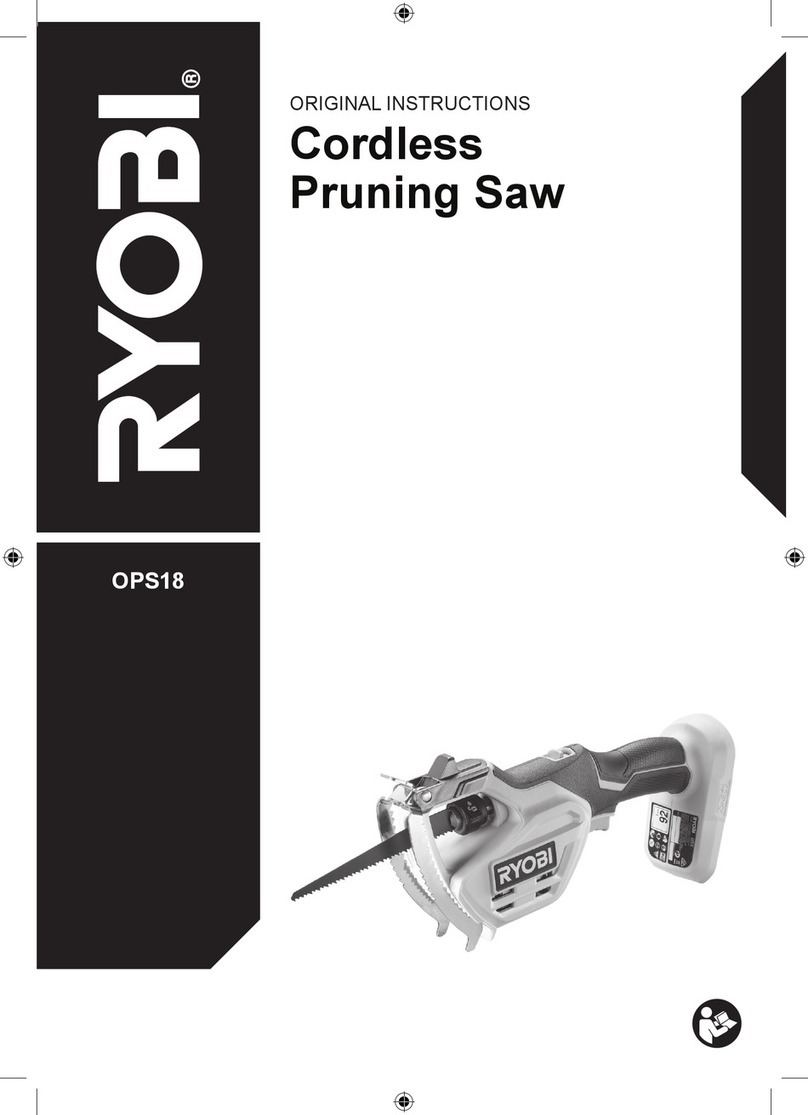
Ryobi
Ryobi OPS18 User manual
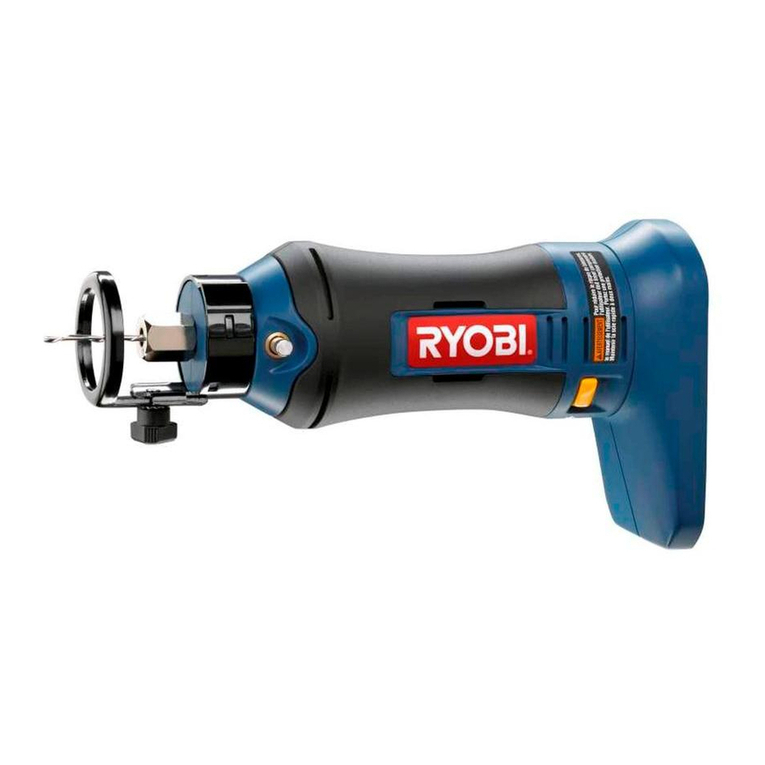
Ryobi
Ryobi P530 Quick setup guide

Ryobi
Ryobi P553 User manual

Ryobi
Ryobi EMS305RG User manual

Ryobi
Ryobi P507 User manual

Ryobi
Ryobi BS902 User manual

Ryobi
Ryobi ETS-1525SC Instructions for use
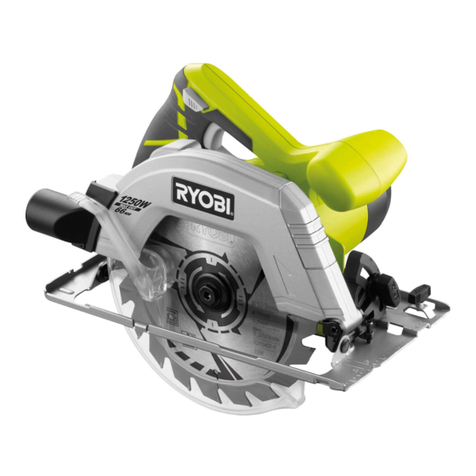
Ryobi
Ryobi RWS1250 User manual
Popular Saw manuals by other brands
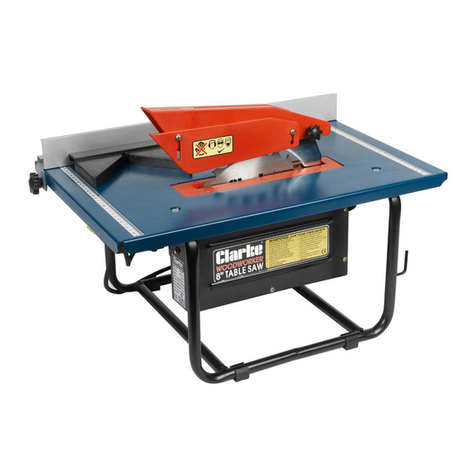
Clarke
Clarke WOODWORKER CTS800B Operating & maintenance instructions

Westfalia
Westfalia Saw Guide quick start guide
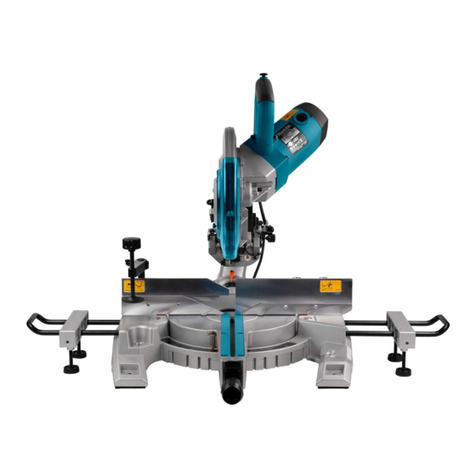
Makita
Makita LS1018LN instruction manual
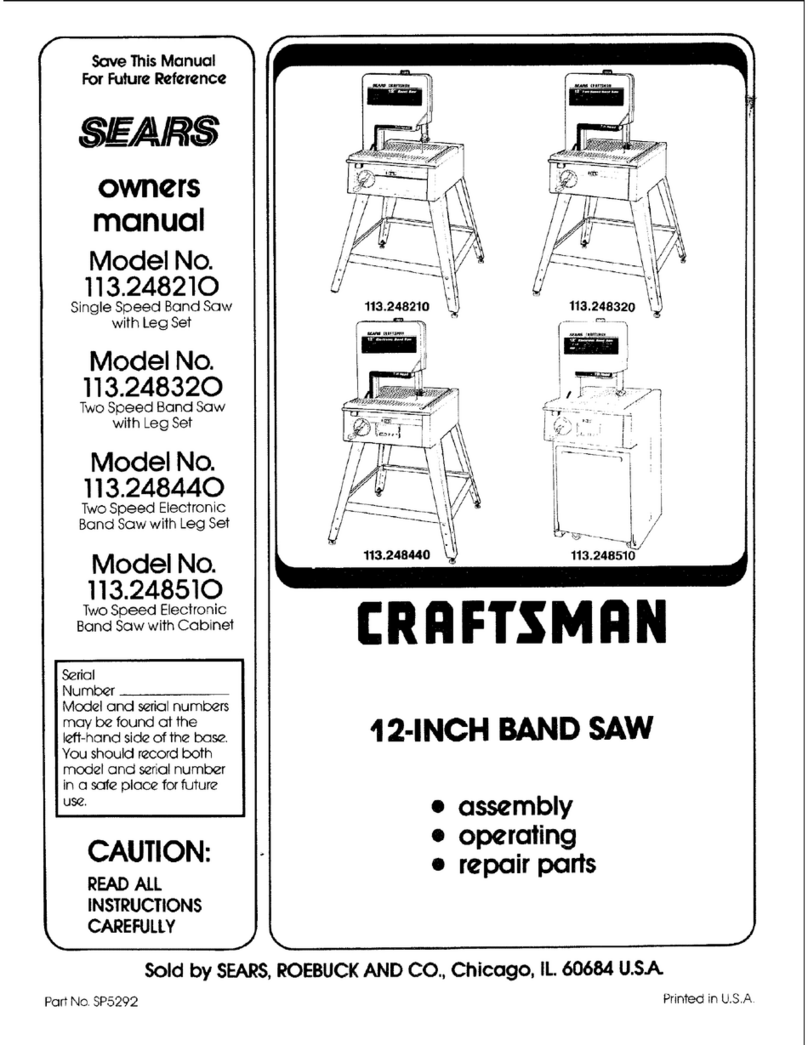
Craftsman
Craftsman 113.248510 owner's manual
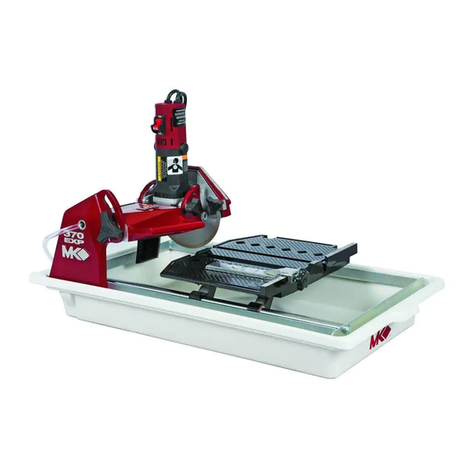
MK Diamond Products
MK Diamond Products MK-370 EXP Owner's manual & operating instructions
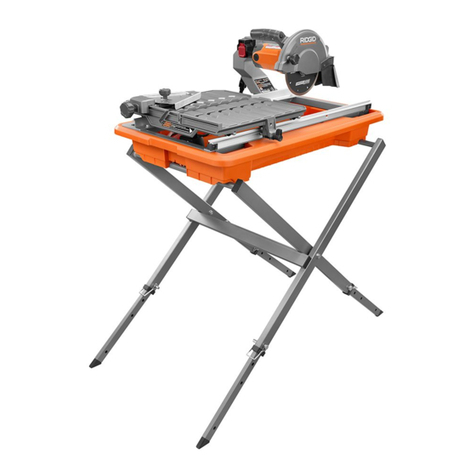
RIDGID
RIDGID R4030 Operator's manual



